Juha I. Uitto's Blog, page 12
March 11, 2012
Oh, Linda Oh!
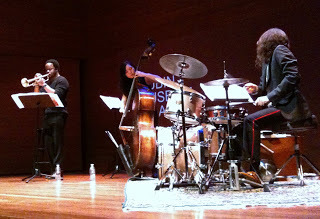
The Harlem in the Himalayas nights at the Rubin Museum of Art are amongst the most innovative and enjoyable events in New York. They take place at irregular intervals on Friday evenings every couple of months, which is probably good. It would be nice to have them more often, but this way the quality and freshness of the music can be guaranteed.
On the first Friday of this month I headed there to catch a rising star in the jazz world, Linda Oh, whom I had read about but whose music I had never heard. The ground floor café space—spacious yet intimate—was slowly filling up and an extra cash bar had been set up in a corner, but many of the patrons were still browsing in the museum shop that, faithful to the museum's theme, displays a comprehensive collection of works focusing on Buddhism and other Eastern cultural topics.
As always, the concert took place in the basement concert hall, which is not set up as your usual concert hall. While the stage is rather large and elevated like in a traditional theater, the chairs are arranged so as to allow for small tables in between for the audience to place their drinks on. When the doors opened just before 7 pm, a fair proportion of the people in the bookstore and lounge moved down to hear the concert. The audience was mixed in age, gender and ethnicity, which to me is always a great plus in itself.
Linda Oh presented her trio consisting of Ambrose Akinmusire on trumpet, Tommy Crane on drums and the leader herself on the bass. She began the concert with a bass solo turning into a vamp that the two other musicians joined in. The band settled into an easy slow groove that immediately grabbed the audience with it. We would hear 1.5 hours of contemporary jazz played on purely acoustic instruments, with interesting harmonies and complex, ever-changing rhythms. Yet, this was music that people could easily relate to.
The Malaysian-born, Australian-raised composer-musician writes music that is both innovative and beautiful, often an elusive goal for contemporary musicians. Linda Oh hasn't followed the usual path through Berklee College of Music that so many young jazz musicians now emerge from. Instead, she studied at the Western Australia Academy of Performing Arts. She then moved to the US and completed a master's degree at the Manhattan School of Music, where she now teaches the bass. Her Aussie accent, albeit moderated by the stay in New York, was still audible as the sympathetic young lady introduced the music in between pieces.
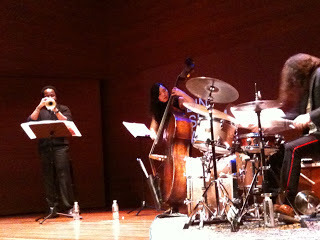
Apart from being a technically and musically skilled bassist, what attracted me was her composing. Her tunes have beautiful melodies that appear deceivingly simple. The trio, with no instrument playing the chords, might appear somewhat limiting harmonically. Then again, the set chord changes played by a piano or guitar can also in themselves become a restriction for the musicians to venture outside. Consequently, many modern jazz players—from Gerry Mulligan and Ornette Coleman to Dave Holland and Joshua Redman—have chosen the more open format. In this case, the Linda Oh Trio was in many ways having the best of both worlds. While they created ample space for adventurousness, there was also structure and harmony in the music. The melodies were often played by the trumpet and the bass together or alternately, in unison or in harmonies. In addition, Linda Oh herself would frequently use double-stops on her bass to create chords. When she soloed, Akinmusire would add long notes or punctuations to back her up like a piano paper might do.
Tommy Crane whose long hair covered his facial expressions for much of the evening proved himself a creative drummer in tune with the other musicians. He used the full arsenal of his small drum kit in a sensitive, albeit at times a bit busy way, alternating between the sticks and the brushes. From my vantage point sitting at the front slightly behind him, I could observe his dexterity and I in particular admired his use of the bass drum to accentuate the meandering music. The rhythms would move between free-flowing rubatos, straight rides and taut hi-hat beats (à la Jack de Johnette), often within the confines of the same song.
Linda Oh's pieces are tightly structured and written through, largely avoiding the traditional theme-solos-theme structure. It was a pleasure to observe the tiny cues—a slight nod or simple eye contact—that signaled the change of pace or mood or the entry of another theme to be played by the trumpet and the bass in between improvisational passages.
Ambrose Akinmusire played some of the most enjoyable and original solos of the evening. Much of the time, he played modestly, in low register, with a soft but broad tone reminiscent of a flugelhorn, only to burst into sparkling solos in a bright broad trumpet sound. His use of the horn's possibilities by way of tone and nuances was startlingly original and outright fun.
Apart from supplying the great material for the concert and leading the trio with a solid hand, Linda Oh also proved to be a bassist to be taken seriously. She has a fluid technique and beautiful natural sound. She used the whole range of the instrument reaching for the low tones above her head, while her solos and melodies often made her bend over to push the strings on the upper reaches of the fretboard.
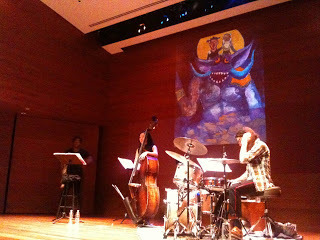
Much of the repertoire this evening came from Linda Oh's first CD, Entry, which features her compositions for the trio (while Akinmusire plays the trumpet on the record, the drummer is different, Obed Calvaire), but the band did perform some new music as well. Her second CD, Initial Here, is scheduled to be released in May and features a different set up, this time with piano and saxophone, and on one sonhttp://www.blogger.com/img/blank.gifg another original performer with Asian roots, Jen Shyu. And on the new album we'll also hear Linda on the electric bass and bassoon, in addition to her big acoustic fiddle.
But this Friday evening we were treated to a varied set of acoustic trio pieces, such as the 'Morning Sunset', the rhythmically enticing 'Fourth Limb', the quietly beautiful 'Patterns', the complex 'Gunners', and the bopish uptempo crowd-pleaser '201'. When the concert was over and I left the hall, the party upstairs had picked up. The lounge was now full of people and a DJ was spinning records in one corner. I decided not to linger but stepped out into the rain on the 17th Street with a satisfied feeling about the state of music in the world.
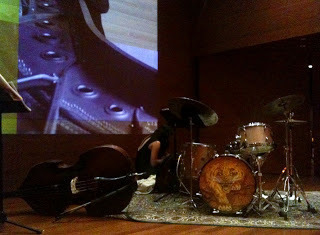
Published on March 11, 2012 15:42
January 15, 2012
The Whale Warriors
 The Whale Warriors: On Board a Pirate Ship in the Battle to Save the World's Largest Mammals by Peter Heller
The Whale Warriors: On Board a Pirate Ship in the Battle to Save the World's Largest Mammals by Peter HellerMy rating: 4 of 5 stars
As Japan is again continuing its whaling in the Antarctic waters against international law and the world's public opinion, this book describing the winter 2005-2006 campaign by Sea Shepherd is very timely. On January 9th this year, under the cover of darkness, three Australian Sea Shepherd activists managed to board the Japanese harpoon ship Shonan Maru No. 2 when it was just 26 km off the Australian west coast. The Japanese proceeded to arrest the environmentalists and took them to Tokyo, where a court released them without charges. The reason for the prompt release was probably that Japan does not want to draw undue attention to its controversial whaling activities.
Japan's insistence to go ahead with its extensive whaling is somewhat baffling. As Peter Heller demonstrates in his book, the government is forced to heavily subsidize the companies doing the whale hunt. There is very little demand for whale meat in Japan (only a tenth of the population confesses to ever eating it) and it has to be pushed on school lunch menus in some of the coastal areas with a high price to the tax payers. Tons of whale meat are piling up in freezers. Yet, more and more is brought in every year. Why? The officials cite traditional culture, but even that is a suspect argument. While some fishing communities, notably on the island of Shikoku, traditionally did hunt whales, this was limited to their coastal waters. Large scale commercial whaling only started when Japan built up its ocean going fleet after Commodore Perry's 'black ships' forced the opening of Japan to the outside world in 1854. The tradition certainly is not based in the ancient Japanese culture. The most likely explanation to the Japanese incalcitrance is nationalistic defiance against foreigners trying to tell them what to do. Sounds infantile? Well, it is, but it wouldn't be the first time.
Japan is a member of the International Whaling Commission (IWC), set up in 1946 "to provide for the proper conservation of whale stocks and thus make possible the orderly development of the whaling industry." IWC is thus not a conservation organization, but works for the long-term sustainability of the industry. So it can hardly be accused of sensationalizing the statistics. Yet, IWC recognizes that many whale species are endangered. On its website IWC acknowledges that many stocks of the thirteen species of 'great whales' have been depleted through over-exploitation. The authoritative Red List of endangered species compiled by the World Conservation Union identifies a number of whales as endangered. These include the Blue Whale, Fin Whale (Japan's self-set quota includes 50 Fin Whales per season), North Atlantic Right Whale and North Pacific Right Whale. In addition, a number of species are identified as threatened or vulnerable. Importantly, there is deficient data for most species to determine their status. Because of this state of affairs and the uncertainty about whale numbers, a moratorium on commercial whaling endorsed by IWC has been in place since 1986 (the UN Conference on Environment and Human Health originally proposed such a moratorium in 1972, but it was voted down by Japan, Russia, Iceland, Norway, South Africa and Panama).
As a response, Japan has circumvented the commercial whaling ban by claiming, quite disingenously, that its whaling program is for research purposes. This lethal research has been criticized by scientists and environmentalists alike. There are now non-lethal research methods that can be used to obtain the same data - and even if there were none, the large catch numbers could never be justified by the research argument. In IWC, a coalition led by by the USA, Canada, New Zealand and Australia has often challenged Japan for its "research" whaling. However, like in the UN, IWC operates on a one nation, one vote basis. Consequently, Japan has been able to purchase the votes of a number of tiny countries by providing them financial support. A number of Caribbean and Pacific Island countries - even the West Africa country of Togo - have voted in line with Japan in IWC following promises of official aid or even just covering travel and expenses of individual government officials. In all fairness, it must be said that there are also other countries that continue to kill whales, including Norway, Iceland, the Danish Faroe Islands and Russia.
When I was on the faculty of the UN University based in Tokyo in the early 1990s, I remember that we were approached by a consultant to the Japanese Ministry of Agriculture and Fisheries who proposed to pay for a study that we would conduct to show that whales were not endangered. During the meeting the gentleman got somewhat carried away and outlined a vision how whales could be domesticated to produce meat and milk for the growing human population. He further accused Western "meat eaters" for an emotional reaction to whaling. When I politely explained that we would gladly consider undertaking such a study, but that we would have to be in control of the study, select the research design and researchers, and that there could be no preagreed conclusions, he got up and promised to get back to us. Needless to say, he never did.
Adventure writer Peter Heller joined Sea Shepherd's ship Farley Mowat on a two-month expedition to the Antarctic in the 2005-2006 season to intercept the Japanese fleet. In 'The Whale Warriors' he provides an interesting and quite balanced account of the challenging trip during which the mostly volunteer crew under the command of Sea Shepherd founder Capt. Paul Watson searches, chases and engages with the Japanese fleet in the Antarctic waters. The book is written in a generally lively manner following the format of Heller's log of the days and weeks at sea, interspersed with information about the history of whaling, the Japanese whaling industry, ecology, the organizations that work against whaling (including Sea Shepherd and Greenpeace), and the international politics surrounding the issues. The format works well overall, but because of the lengthy search for the Japanese whalers and Heller's faithful depiction of the tedium at sea, the book feels a bit long (it could easily have been 50 pages shorter, I think). Even if the author's descriptions of the weather, the sea, the penguins, albatrosses and other sea birds, the icebergs, are beautiful, they also become somewhat repetitive. Finally, it is only on page 215 when the Farley Mowat first finds the location of the Japanese factory boat Nishin Maru and things start speeding up.
In the meantime, we meet the dedicated environmentalists from many countries (USA, Canada, Holland, Sweden, Brazil, South Africa, Australia, France) that make up the crew. These women and men form an interesting bunch, by no means homogenous in their philosophy, but all committed to saving the large, peaceful and highly intelligent animals. Heller observers exchanges that highlight the tensions between unexpected groups, such as between vegans and vegetarians or between conservationists and animal rights activists. His observations are often quite revealing and at best very funny. When the small helicopter onboard returns from a surveillance flight and performs a delicate landing on the deck of the ship rolling in heavy waves, Heller sees how the deck crew took only seconds to secure the landed chopper to the deck. "Pretty good for vegans with advanced degrees," he quips (page 267).
The book also sheds light on the continued rift between Sea Shepherd and Greenpeace. Paul Watson was one of the founders of Greenpeace and served as its Director from 1972 to 1977 when he left to found Sea Shepherd. He was growing frustrated with what he considered ineffective methods of Greenpeace, believing in a need for more direct action. The quartermaster of Farley Mowat on this trip is Emily Hunter, daughter of the Greenpeace co-founder and first President, the late Robert Hunter. Greenpeace manages to locate the Nishin Maru much before Sea Shepherd, but refuses to release the coordinates. The schism appears to be mostly with the top of the organizations and individual crew members of the Greenpeace ship Esperanza leak updates to Watson. As Farley Mowat finally sails to engage with Nishin Maru, Esperanza crew cheer it on. The trouble with Greenpeace non-confrontational tactics is that they only look on and document as the Japanese proceed to slaughter the whales in the most brutal and inhumane manner imaginable.
Whether the Sea Shepherd's more direct approach is any more effective is the question. As the Nishin Maru and its harpoon boats see Farley Mowat approaching they escape, only to move to another location to continue their hunt. Both organizations clearly have done much to bring the vicious and criminal activity to the forefront and thus influencing world opinion.
Yet, politics is what it is. Most of Japan's whaling takes place in the areas designated as off limits under the international moratorium and much in the territorial waters of other countries. Heller points out that if the whaling fleets were from less powerful developing countries, countries like Australia would not hesitate to intercept and arrest them in their territorial waters. Indeed, even earlier this week the Australian prime minister Julia Gillard criticized the Sea Shepherd activists for boarding the Shonan Maru, which was engaged in illegal activities in Australian territorial waters.
View all my reviews
Published on January 15, 2012 13:53
December 19, 2011
Kathmandu and Bhaktapur: Growth and Conservation
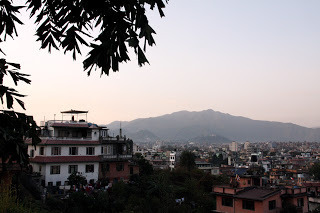
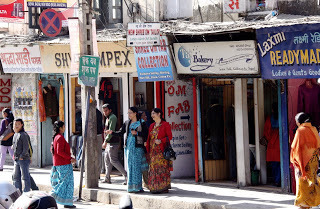
Kathmandu had changed in the 21 years I had not visited. The city had swelled with migrants from the countryside and was now home to more than 4 million people. In the meantime, the valley in the Himalayan foothills where the city is located had not miraculously expanded. Consequently, the place was now crowded. It was no longer the quaint village-like old town it had been in the late-1980s and early-1990s when I used to come here. On my first morning back, I went to the New Road area in the center of the city. Most of the buildings were still the same old ones, now distinctly rundown, although new commercial buildings with glass walls that reflected the scenery and shiny malls had sprung up here and there. The Chinese center looked particularly impressive. The leisurely pace was gone and the place was bustling with people hurrying to get wherever it was they were going. There were peasant looking women and men carrying huge loads on their backs and heads, their sun-drenched faces lined and leathery making them look old (although many were probably younger than me). Women wearing colorful saris mingled with young people dressed in jeans. A couple of farmer women sat on the pavement selling fruit from baskets amidst the busy pedestrians.
Most obviously, there was the traffic. Where there had been lots of bicycles and few cars, the bikes were now almost gone—I only saw one pedicab that morning—and cars, motorbikes and scooters ruled the streets. A lone traffic police stood on the pedestal of a status at an intersection trying to create order in the chaos. The officer's mouth and nose were covered with a cloth mask, wisely, as the exhaust fumes would choke anyone standing in the middle for any length of time. The driver from our office who had taken me downtown had things to say about the traffic and the pollution. "These people are from the rural areas. They have never lived in the city and don't know anything about traffic rules, nor did they ever learn to drive in the first place," he lamented. As we waited at another junction where another officer, this time a woman, made valiant efforts to directing the crowds, the driver had a long story about futile efforts to control air pollution that had been in place for the better part of the past decade. The bottom line seemed to be that the government did not want to enforce the rules, as it would have meant replacing all the official vehicles that the city nor the national government could never afford. Consequently, everyone continued to use the noisy motorbikes and old cars without catalyzers, and the antique buses continued to belch thick smoke into the mountain air. It's not that there were no new cars, as well, just that these had been added to the existing fleet of ancient vehicles.
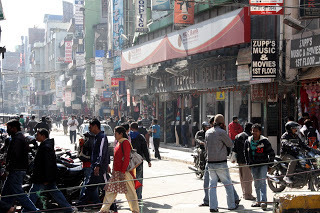
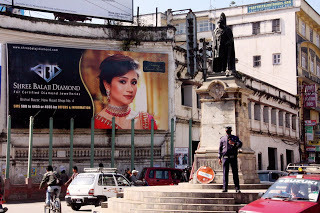
Even under normal circumstances, developing country cities grow at breakneck speeds. People move to the cities for the economic opportunities that exist in them, even if it means living in a slum. At the same time, they continue to have many children, as if from an old habit, although the children in the city no longer provide the same useful workforce they were on the farm. With improved healthcare, sanitation and nutrition, child mortality has decreased and more children survive. All this contributes to a huge boost in city sizes. Now more than half of the world's population lives in cities, many of them enormous mega-cities. Out of the 10 largest cities in the world, 6 are now in the developing countries (and 7 in Asia).
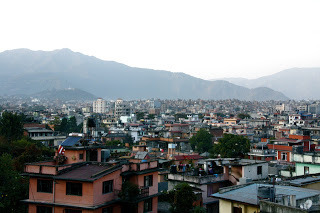
Kathmandu's growth was still a special case. A long-lasting Maoist rebellion had chased people away from the countryside. Originally, the Communist Party of Nepal (Maoist) declared an armed rebellion on February 13, 1996, with the objective of establishing a communist state. The Maoists opposing what admittedly was rather a feudal system prevailing in Nepal terrorized people for a decade. There were forced 'land reforms,' whereby poor farmers lost their lands to collectivization, and plenty of violence against perceived enemies of the revolution, as well as between the Maoists and the government forces. Many people died during the conflict. At the same time, as so often happens, some revolutionaries descended into criminality, while criminals saw the opportunity to make money by pretending to be revolutionaries (think of similar cases in, say, Colombia or the southern islands of the Philippines). Kidnappings for ransom became common and the victims often got killed by the bandits whether their family or company paid up or not. In the Terai region in the south, gangs would haul their victims across the border to India not to be seen again. The situation only changed when a comprehensive peace accord was signed on November 21, 2006, which allowed the Maoists to join the transitional government. While they later emerged as the largest party in the Constituent Assembly, they never gained the majority. Instability in Nepalese politics has continued.
The purpose of my trip related to an evaluation my office had conducted about UNDP's contributions to national development results in Nepal over the past 8 years. These had been particularly turbulent years in the history of the country. Apart from the internal conflict that had peaked during the period, an extraordinary event had added to the extreme political turmoil. On June 1, 2001, Crown Prince Dipendra in an alcohol fueled craze shot and killed nine members of the royal family, including his own father King Birendra and mother Queen Aiswarya. It is said he was mad at his parents for opposing his marriage to a girl from a rival family. The revered royal family had been virtually the only institution that had kept the kingdom together. Following the regicide, a new king, Gyanendra, was crowned. This signaled the beginning of the end of the monarchy. Gyanendra dissolved the parliament and suspended elections indefinitely in 2002 following the failure of peace talks with the rebels. The state of emergency was lifted only in April 2005 under international pressure and the parliament was finally reinstated a year later. Immediately afterwards, the newly established parliament, quite understandably, voted unanimously to curtail the king's political powers. In December 2007, the parliament voted to abolish the monarchy altogether and the constituent assembly declared Nepal a republic on May 28, 2008.
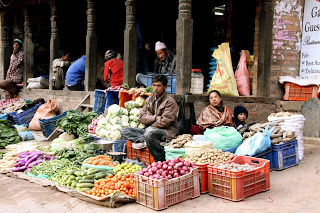
During this period, UNDP had done its best to support post-conflict recovery and a transition to democracy. Things were peaceful now and Nepal had been turned into a parliamentary democracy (with the Maoists learning to play by the rules in the parliament) with an emerging federal structure. Local elections had not yet been held—the security situation did not yet allow for it and there was too much uncertainty in the government—and consequently appointed local officials did not feel accountable to the electorate. We heard lots of complaints about rampant corruption in the rural areas.
One afternoon I had free time and joined one of our local consultants, Kanta Singh, who had promised to take our South African consultant Angela Bester to visit Bhaktapur, a World Heritage Site just half an hour's drive to the east from Kathmandu. Half an hour, that is, without traffic. Including the driver, we were four people crammed into the tiny Hyundai as we hit the traffic. We started in Lalitpur, a peaceful neighborhood of small streets on a hill where I was staying, and headed across the city. The road towards the airport was being widened. For already two decades, apparently, there had been a ban to construct buildings within a certain limit from the existing road because of the eventual plans to widen the road. However, people had ignored it and now, finally, when the road project was underway, the authorities were in the business of leveling illegally constructed houses. We passed official buildings heavily guarded by police in camouflage uniforms and riot gear armed with guns and long sticks. The congestion got worse before we reached the city limits. In one spot, hundreds of small vans and buses transporting people seemed to stop to let off their passengers and to attract more, thus creating a near standstill. The road passed just below the landing route to the airport and several planes appeared to be heading straight towards us only to roar past almost touching the rooftops.
Once we hit the highway towards Bhaktapur, the traffic eased and our car picked up speed. "Ten years ago, this was an agricultural area and we came here to get our vegetables directly from the farmers," Kanta explained. Now the entire road was lined with new construction, buildings of up to 5 stories high. In between there were still small patches of agriculture. Rice paddies could be seen on the slopes leading to small creeks. What struck me was how shoddy the construction looked. Most buildings seemed to consist of red bricks piled up on top of each other, often in a seemingly haphazard way. Nepal did have a building code, according to Kanta, but nobody really enforced it. Sitting on the edge of the Indian and Eurasian plates, this was earthquake country and I suspected most of the new buildings would not stand a chance if a big one hit the area.
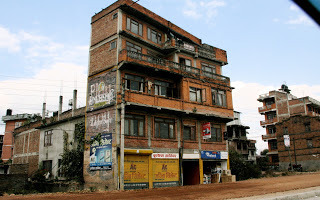
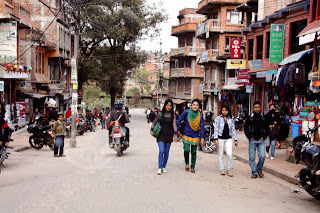
Bhaktapur, just 13 km east of the modern capital, is considered the cultural capital of Nepal. It has been restored with technical cooperation from Germany and is recognized by UNESCO as a World Heritage Site. Originally an agricultural market and artisan town, its history can be traced back to the 7th century C.E. It is built on a hill with narrow winding roads. According to tourist information, it is "geographically shaped as a conch-shell and geometrically designed into the Tantric fabric shaped Shree Yantra." I take them at their word on this. Suffice it to say that the city is lovely and wonderfully preserved. It is still a perfectly living piece of history. The artisanal legacy of bronze-casting, carving, masonry, painting and other crafts lives on, while much of the economy seems to have turned to the tourist industry, with numerous small shops lining the streets. As we headed towards the Durbar Square in the middle of the town, we met with a wedding celebration. The proceeding was headed by a brass band that was blowing away with abandon, the trumpeters, other horn players and drummers dressed snappily in red jackets. Old men and women carried traditional items and candles in front of the small car wrapped in celebratory decorations that was carrying the wedding couple. The guests—men dressed in Western suits, women in gorgeous saris of deep red, yellow, green and gold—followed behind on foot.
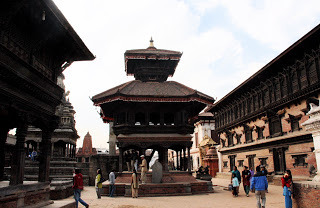
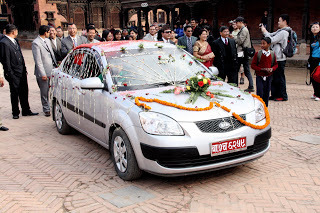
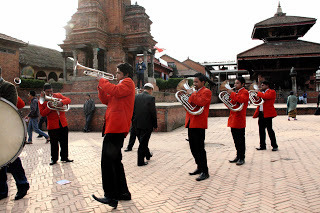
Separating ourselves from the celebrators, we explored Bhaktapur on foot for the next 3 hours. Here in the town between the fabulous squares, like the Durbar, Taumadhi and Dattatreya Squares, that housed all the incredible temples and palaces, regular people lived. Their houses were old and many still not renovated. We could see signs from old earthquakes that had bent and twisted old brick walls into odd shapes. Even the amazing five centuries old Fifty-Five Windows Palace was badly damaged in the powerful 1934 earthquake. A beautiful little girl was leaning against the wall of her house—several stories high—that had cracked so badly that the residents had erected a pole in the adjacent alley to prevent the side wall of the building from collapsing.
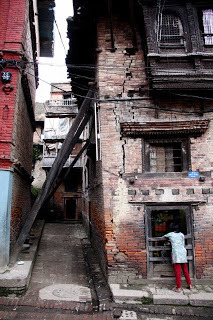
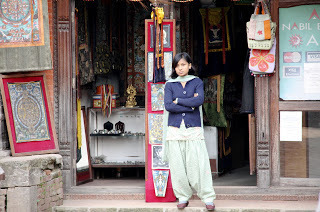
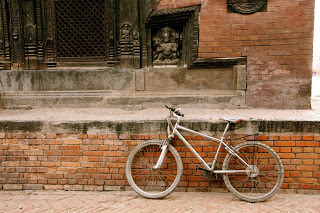
One of the beauties of Bhaktapur and Nepal in general is how for hundreds of years Buddhism and Hinduism have existed peacefully side by side. Bhaktapur has temples for both religions, but sometimes they seem so mixed that it is hard to say which religion they really belong to. I suppose the correct—and most beautiful—answer would be: they belong to both. On another morning when we had a few hours of free time between appointments, Angela and I walked over to Patan Square, another restored World Heritage Site in Lalitpur. In its museum I again reflected with fascination upon the intermingling of the Buddhist and Hindu traditions. Not only were they practiced side by side, their very deities and sacred texts were intertwined. (Similarly in Japan, where it is said 90% of the people are Shintoist and 80% are Buddhist, religions—or perhaps more correctly traditions—coexist. One cannot help wonder what it is with these Middle Eastern religions—Judaism, Christianity and Islam—that makes them so intolerant of what each sect perceives as the only correct orthodoxy.)
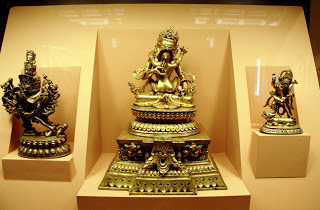
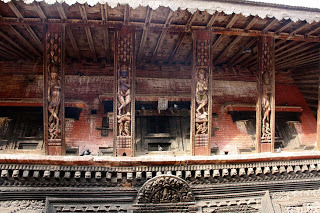
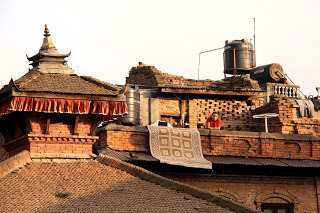
We had a good guide in Kanta's driver whose home was close by and he was quite familiar with Bhaktapur and could show us out of the way attractions. At one point he led us through a small porch leading to a tiny inner yard in between residential buildings. The yard contained a small Hindu temple with an altar for sacrifices attached to it. The altar and the ground beneath it were splattered with the red of the blood of the chicken and goats that had been slaughtered there. A beautiful black cat with a shiny fur presided over the square languidly strolling around, ignoring us.
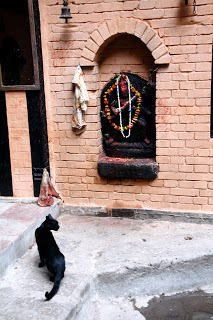
One of the interesting parts of the walking tour was to observe how the old social mores still prevailed. Kanta showed us a number of water wells, which were traditionally social gathering points for women. A particularly large one was protected by a statue of a cobra, with a serpentine carving surrounding it. The water points could be found in many places of the city and it was clear they still served a social function for the women. The men stuck to themselves and when the afternoon advanced one could see pairs and groups of them sitting around the squares, often on the steps leading to temples or palaces making them part of the everyday life of the town dwellers.
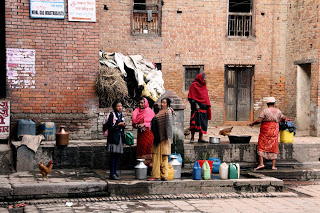
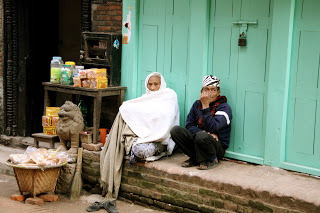
I wanted to buy some good Nepali tea, which is similar to but less well known than Darjeeling (some tea connoisseurs even consider the Nepali variety to be superior to the Indian). I was guided to a small store kept by a sweet and rather sophisticated young couple. On the wall there was a snapshot of the couple in Paris where they had gone for their honeymoon. They showed me the various varieties from the most highly priced white-tipped tea. My goal was to settle for the second flush, which is harvested in the season between May and July, and has a lush mellow taste.
While inspecting the teas, I couldn't help getting carried away by the lovely flute music coming from the stereo. I asked the husband about it and he explained it to be traditional Nepali music. The band, Kutumba, plays traditional Nepali tunes and instruments—flutes, strings, drums and bells—in an improvisatory style. When we had established that I was particularly fond of Asian flute music, he introduced me to a contemporary version by Kala Chakra, which was now popular in Nepal. "Lounge," I suggested as we sampled the music; "Fusion," corrected the owner. Either way, the music captured the tradition in a contemporary electronic, yet lovely manner. Later in the evening, beautiful flute sounds again drifted to my ears. It turned out that there was another wedding procession that had made a more traditional musical choice, with a band of young people playing the bamboo flutes from the region.
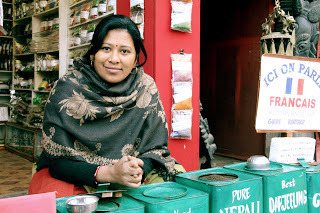
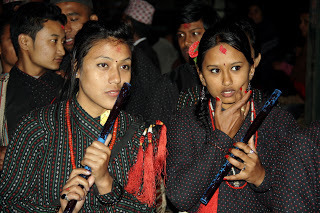
By the time we returned to Kathmandu, the night had fallen and with no streetlights it was pitch dark. The driver decided to take a shortcut through Patan. Its narrow streets were full of people, cars, motorbikes, dogs, an occasional goat. Three-wheeled motorized rickshaws, here called 'Tempu' and larger than the famous Tuk-Tuks of Bangkok, were cruising the streets and abruptly stopping for passengers. Our tiny Hyundai zipped in between buildings, people and vehicles, filling any small space that would open up. At times we got stuck for a minute or two as a truck or a larger vehicle would come from the other direction (luckily, most of the cars in Kathmandu are small). Then again the driver would accelerate to what I considered a dangerous speed when he'd see an opening. Horns were blaring all around us as every user of the road employed the same strategy of advancement. On several occasions I was certain that we'd hit a lady waddling on the side in a sari, or a family walking in a group as if they had all the space in the world, but nothing happened. It was just me who was not used to the going.
Finally we reached Lalitpur and our hotel, a veritable sanctuary so close to the madness of the commercial city. The dry air had been so saturated with dust that I noticed my throat was parched. That was helped by a cold Everest beer before washing off the dirt in a hot shower. Somehow despite its uncontrollable growth and seeming chaos, Kathmandu has maintained its charm and humanity. Efforts to restore and renovate old towns like Bhaktapur and Patan are important beyond their value as repositories of history and culture, as they are attractions that bring much needed income to the country. The fact that both are also living environments where people lead their lives is a highly positive aspect. The harmony that exists between the Buddhist and Hindu traditions should serve as an example for many other places.
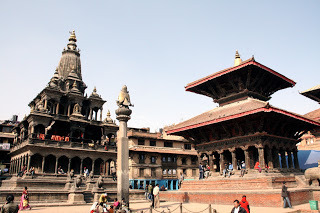
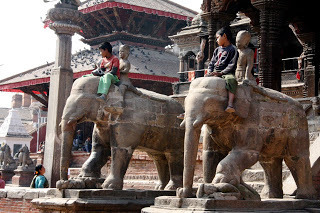
Upon my return home, I rummaged through my bookshelf for some old books about Nepal to revisit how the country was described just two decades or so ago. (In the dust jacket of one, Nepal: Socio-Economic Change and Rural Migration by Poona Thapa, I discovered the invoice from Ratna Pustak Bhandar booksellers in Kathmandu where I had purchased the book on May 16, 1990, for Rp. 327.60.) One striking figure was that in 1991, Kathmandu had had a population of just 421,000, indicating that the city had actually grown ten-fold since then. But even before that, the growth had been tremendous, as the 1981 data showed a population of only 235,000 for the city! Many issues that were highlighted by the older publications are still valid concerns: poverty, major inequalities between regions, heavy internal migration. Despite these challenges, much progress has been made, especially since the worst of the political troubles have calmed down. Measured on the UN Human Development Index, Nepal is still on the 138th place amongst the 169 countries included, but its rating is constantly and rapidly rising. One must hope that this trend will continue. Much will depend on the continued political stability, peace and security in the country.
Published on December 19, 2011 16:05
December 5, 2011
The Lunatic Express by Carl HoffmanMy rating: 4 of 5 star...
 The Lunatic Express by Carl Hoffman
The Lunatic Express by Carl HoffmanMy rating: 4 of 5 stars
This is a travel book focusing on modes of transportation that most travellers would prefer to avoid. Carl Hoffman's stated desire was to circumnavigate the globe on the cheapest and most dangerous forms of mass transit. For most of humankind, travel was no pleasurable touring, but a necessary movement from point A to point B often involving terribly long and uncomfortable, not to mention perilous, trips on decrepit buses that would plunge into gorges from the winding mountainside roads that they travelled, on overcrowded, capsizing ferries, unmaintained ancient aircraft, and trains that were so stuffed with people that they just fell off on the tracks. Hoffman's travels over several months involved all of the above, as he left his home in Washington, DC, and toured around the Andes and Amazon basin in South America, the roads and railroads of East and West Africa, the notorious deathtraps that ferries in Indonesia and Bangladesh were. He had weeks of relative leisure in India before flying to Afghanistan on the national airline Ariana (a.k.a. Scariana). Then returning home by train and gas truck through China, Mongolia and Siberia. Through all these segments of travel he reports on the exotic places he encounters, the hairy situations arising and, most importantly, the various people he meets.
Carl Hoffman is plagued by wanderlust. He is middle-aged, married with three kids, a journalist, but for a long time he has felt compelled to leave the comforts of home behind and travel. This is the other theme of the book: man's struggle between loneliness and belonging. The book gets quite personal, as Hoffman misses his family while at the same time feels alive only travelling in risky places amongst strange people. At times his descriptions of his own addiction to danger seem slightly too heroic, but at least I personally can very well relate to his contradictory feelings. He observes with some envy people in the poor countries that he visits and interacts with, how they all have strong bonds in their communities and families; at the same time, he knows that he could never live that way, with no privacy or time alone. When he finally is returning home, he notes that he was settling in and getting a little bored on the trip. He concludes that it was time to go home: "Travel was only worthwhile when your eyes were fresh, when it surprised you and amazed you and made you think about yourself in a new way. You couldn't travel forever. When you stopped seeing, when you lost your curiosity and openness to the world, it was time to return to your starting point and see where you stood" (p. 263).
I found the book to be well worth reading, well written, even quite wise. Although the narrative was generally entertaining, I found there was a certain unevenness to the chapters (probably reflecting the interestingness of the segment and the people Hoffman happened to meet). The cover of my edition touted it as a "Wall Street Journal Book of the Year." I wouldn't go that far and the accolade baffled me initially, before I realized that for an average WJS reader the book would cover territory that was strange and likely unsightly. The Lunatic Express certainly serves its purpose as an antidote to seeing travel only through the lens of comfortable business travel or relaxing tourism. Carl Hoffman made a superb effort to experience travel the way the majority of the world's people experience it. In the process he met numerous interesting and hospitable people whom he recalls frequently with warmth, always with understanding.
View all my reviews
Published on December 05, 2011 20:45
October 23, 2011
A Week (or Two) in Music: Only in New York
It's been a New York week—well, I guess every week is like this in New York. Actually, I only listened to three live performances, although there'd be something worthwhile to hear every night and I in fact had noted a couple of more possible concerts in my calendar. That's what I do: I scan the opportunities to listen to some interesting music in advance and mark them in my Google calendar, so that I won't forget about them or won't be at a loss if one evening I just feel like catching some act. The reason why I thought of jotting down this week's crop is because the three acts were all quite different from each other but represented broad categories of music that are all close to my heart. All were also played in quite intimate settings and mostly with acoustic instruments.
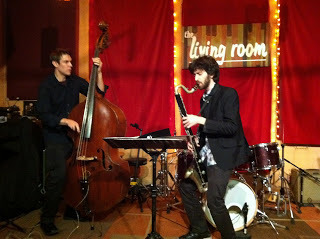
First, on Tuesday night (October 4), there was a duo performance by two of my favourite instrumentalists at the Living Room in Manhattan's Lower East Side. As it happens, I also know both Oran Etkin and Ben Allison personally and they are both the nicest boys in the business. What I didn't know is that they played together—and apparently it is a perfectly new thing. Their performance was part of celebrating the Independent Music Awards—Oran had just won the 'Best World Beat' award for his album Kelenia—and there was a succession of winning bands at this bar-cum-performance space. Oran and Ben had a half hour slot in the middle of the evening, which they filled with three pieces of fantastic communication with acoustic wooden instruments. All compositions were Etkin originals, starting with the hypnotic Kelenia from his African music project. This time played only on bass clarinet and contrabass, the tune produced a wonderful atmosphere with its ostinato-like theme. This was followed by Wake Up, Clarinet!, an entertaining number from Oran's popular children's album. It's easy to see why kids would find it irresistibly fun when the cheerful bearded guy has a great time communing with his clarinet. The duo's last piece was Lacy—dedicated to the soprano saxophone innovator Steve Lacy—a quirky jazz tune in which the musicians' interplay was again seamless, with Ben providing a solid basis for the music as he pulled double stops on his bass.
[image error]
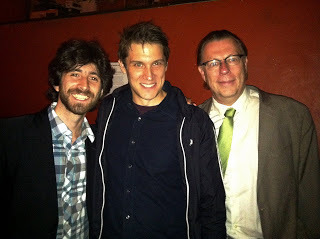
(Exceptionally, these pictures are not mine, but by Yoko Takahashi, so that I could get into the photo with the guys.)
The following night I headed to the City Winery to catch a concert with Bebel Gilberto, the famous contemporary Brazilian singer. The star spent last summer as artist in residence at City Winery and performed several sold-out concerts. I only managed to get my act together and buy a ticket to the last extra one organized as an in August due to high demand. Alas, the concert was rescheduled due to the rare Hurricane Irene that hit New York just on the evening when Gilberto was supposed to perform. It thus took more than a month to organize the concert until Wednesday, October 5. In August, the extra concert was supposed to be an intimate evening only with the songstress and an acoustic guitarist. When I entered the crowded hall on this Wednesday evening, it was clear we would be now treated to the full band. There was a drum set, keyboards and amplifiers on stage. There was tangible electricity in the air—and the audience would not be disappointed. The diva, dressed in a tight black dress, was at her best, chatting with the audience in between the tunes, with a glass of wine constantly at her side. The daughter of legendary Brazilian musicians, Joao Gilberto and Miúcha, Bebel carries the torch of the bossa nova tradition that her parents were amongst the core group creating. Despite the five-piece band, the music remained very intimate and the volume at a very moderate level. She performed a long set consisting of hits from her own albums as well as a number of older songs. Personally, I was most taken by Jorge Continentino, whose alto flute provided an atmospheric ambience to most of the songs. On one tune, he switched to a horizontal bamboo flute, which he handled very nicely and entirely in tune (not always so easy with a bamboo flute). There was also a trombone in the band, which together with the alto flute produced a pleasant mellow addition to the music. At one point of the evening, Bebel asked an audience member to pass a candle from the table to her. Then she started the birthday song, approached the trombonist for a hug and passed the candle on to him. The birthday boy was so moved that he started to weep. "More than 20 years of friendship," Bebel declared to the audience. Clearly, the star has a faithful relationship with her musicians. We were allowed to witness some intimate moments of her singing accompanied only by Bebel's long-term guitarist, Masa Shimizu. On some of the later pieces of the evening, the tempos increased. Continentino switched his small pipes to a large curved baritone sax with which he joined in funky riffs with the trombonist. All in all, a superb concert.
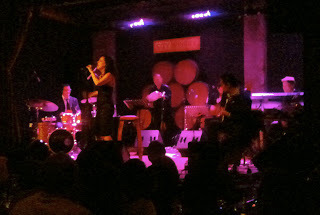
Then, on Sunday, Yoko and I headed to one of our favourite Sunday afternoon places, the Noguchi Museum in Queens. The afternoon Music in the Garden promised shakuhachi music with Elizabeth Brown. We couldn't have been luckier, as after a cool spell of autumn weather New York was experiencing Indian summer. We sat out in the garden with some 50 other listeners enjoying a most beautiful sunny afternoon amongst Isamu Noguchi's sculptures and the verdant trees. Elizabeth Brown is an award winning composer and performer on the shakuhachi, the western flute and theremin. She took her place under a large aspen whose leaves had already turned largely bright yellow. Her set alternated traditional shakuchachi honkyoku—Oshu Sashi and Sokaku Reibo—with her own compositions, Hermit Thrush (1991) and From Isle Royale (2005). Her own pieces combine contemporary music aspects with traditional Japanese tonalities. Both pieces were inspired by the sounds of birds she had listened to while composing the music in the middle of nature. Here, the meditative sounds of shakuhachi mixed with the more urban soundscape of the inevitable helicopters and cars crossing Queens. For the last piece, Shika no Tone—another honkyoku tune in Kinko-ryu style—Elizabeth Brown called Ralph Samuelson to join her. She introduced Ralph "her mentor, teacher and friend." The two flutists moved to the opposite sides of the garden creating a lovely echo mimicking the distant cry of the deer that the tune's title implies. Moving slowly closer to each other, the stereo effect created by the two shakuhachis was purely lovely.
[image error]
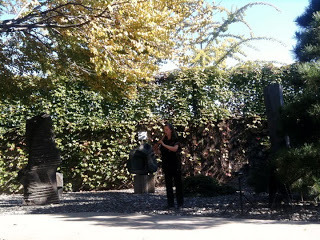
Originally, I had intended to just describe these three exquisite concerts in such disparate styles and venues all played during the same week in this city—hence the title of this blog. But as I failed to complete writing this in time, I feel compelled to add to the mix. On the following Sunday, October 16th, we took our friend Masako, visiting from Tokyo, to Le Poisson Rouge to listen to a piano recital by Peter Hill. The concert was constructed around the music of Olivier Messiaen, whose premier interpreter the British pianist is. He made a smart strategic move by starting the modern concert with J.S. Bach, making the connections that both Bach and Messiaen were organists and both also superb improvisers. The beautiful start served its purpose of focusing the attention of the audience in the concert venue that doubles up as a restaurant. The rest of the evening consisted of pieces by Messiaen, with the exception of one piece by Toru Takemitsu composed in memoriam of the French composer. The highly sympathetic Peter Hill explained that he had selected the program around Messiaen's compositions inspired by birdsong (something in common with Elizabeth Brown's shakuhachi music!), starting with La Colombe that Messiaen had written in 1926 when he was just 18. Later pieces from the 1950s and Cantéyodjayâ that Messiaen composed while in Tanglewood in 1949 demonstrated how his musical language had evolved. The last number was lovely, contrasting the dark night when the composer had been driving in France with his wife, with the competing coloratura of a pair of larks and a nightingale they had observed. Messiaen was an accomplished ornithologist who incorporated birdsong systematically in his music. I was absolutely delighted to have decided to come to the concert. Messiaen's music was not very familiar to me and this recital, enhanced with Peter Hill's commentary, truly opened up his music to me. As an encore, Hill played a piece that Messiaen had written as a sight reading exercise for his students. Apparently, the master had written many such exercises but this was the only one that had survived—a tragedy of 20th century music, as recounted by Hill.
[image error]
Then finally, on Tuesday, October 18th, Masako's last night in New York, she and I went to the Jazz Standard while Yoko was rehearsing for her own forthcoming performance. The work we heard was Race Riot Suite composed by Chris Combs and performed by the Jacob Fred Jazz Odyssey. The lengthy suite in 12 parts turned out to be an incredible tour de force by both the composer and the orchestra. I had picked the show only based on the description, which explained that the suite had been composed to tell the story of the evolution and destruction of Greenwood, a highly successful African-American neighbourhood in Tulsa, Oklahoma (the centre of Greenwood was known as the "Black Wall Street"). On May 31, 1921, in an occurrence of exceptional racial conflict, white mobs invaded Greenwood and as a result at least 40 people were killed and over 800 were hospitalized. Some 35 city blocks were destroyed by fire and an estimated 10,000 people were left homeless. The all-white Jacob Fred Jazz Odyssey hails from Tulsa and consists normally of four musicians: Brian Haas, Josh Raymer, Chris Combs and Jeff Harshbarger. A unique feature of the band is that to the normal piano trio is added a lap steel guitar played by Combs, the writer of the Race Riot Suite. For performing the Suite, the band was strengthened by three horn players: Steven Bernstein (trumpet and slide trumpet), Mark Southerland (tenor and soprano saxes) and Peter Apfelbaum (tenor and baritone saxophones). This was one of the best and most innovative pieces of new jazz music that I have heard in a long while. The composition builds upon a long tradition of New Orleans jazz and ragtime and contains clear nods towards the great composers and band leaders, such as Duke Ellington and Charles Mingus. The expression is contemporary and the harmonies very interesting, with the steel guitar's wails often blending in with the horns. Every player contributed wonderful solos throughout the music, so I would just highlight a couple that stayed with me. Overall, I loved Apfelbaum's work on both of his saxes. The tenor was exceptional warm (and contrasted well with Southerland's stormier approach) and there was an interesting moment when the baritone soloed only against Haas' piano accompaniment (and what a rare treat it was to hear a second excellent baritone player in just two weeks!). Overall, Haas provided some entertaining piano playing, while Bernstein's trumpet channelled Roy Eldridge and Cootie Williams transported into the 21st century. Harshbarger and Raymer on bass and drums soloed less, but ensured that there was a solid rhythmic structure—at times chaotic, but always firmly rooted—to this complex music. This was programmatic music at its best.

First, on Tuesday night (October 4), there was a duo performance by two of my favourite instrumentalists at the Living Room in Manhattan's Lower East Side. As it happens, I also know both Oran Etkin and Ben Allison personally and they are both the nicest boys in the business. What I didn't know is that they played together—and apparently it is a perfectly new thing. Their performance was part of celebrating the Independent Music Awards—Oran had just won the 'Best World Beat' award for his album Kelenia—and there was a succession of winning bands at this bar-cum-performance space. Oran and Ben had a half hour slot in the middle of the evening, which they filled with three pieces of fantastic communication with acoustic wooden instruments. All compositions were Etkin originals, starting with the hypnotic Kelenia from his African music project. This time played only on bass clarinet and contrabass, the tune produced a wonderful atmosphere with its ostinato-like theme. This was followed by Wake Up, Clarinet!, an entertaining number from Oran's popular children's album. It's easy to see why kids would find it irresistibly fun when the cheerful bearded guy has a great time communing with his clarinet. The duo's last piece was Lacy—dedicated to the soprano saxophone innovator Steve Lacy—a quirky jazz tune in which the musicians' interplay was again seamless, with Ben providing a solid basis for the music as he pulled double stops on his bass.
[image error]

(Exceptionally, these pictures are not mine, but by Yoko Takahashi, so that I could get into the photo with the guys.)
The following night I headed to the City Winery to catch a concert with Bebel Gilberto, the famous contemporary Brazilian singer. The star spent last summer as artist in residence at City Winery and performed several sold-out concerts. I only managed to get my act together and buy a ticket to the last extra one organized as an in August due to high demand. Alas, the concert was rescheduled due to the rare Hurricane Irene that hit New York just on the evening when Gilberto was supposed to perform. It thus took more than a month to organize the concert until Wednesday, October 5. In August, the extra concert was supposed to be an intimate evening only with the songstress and an acoustic guitarist. When I entered the crowded hall on this Wednesday evening, it was clear we would be now treated to the full band. There was a drum set, keyboards and amplifiers on stage. There was tangible electricity in the air—and the audience would not be disappointed. The diva, dressed in a tight black dress, was at her best, chatting with the audience in between the tunes, with a glass of wine constantly at her side. The daughter of legendary Brazilian musicians, Joao Gilberto and Miúcha, Bebel carries the torch of the bossa nova tradition that her parents were amongst the core group creating. Despite the five-piece band, the music remained very intimate and the volume at a very moderate level. She performed a long set consisting of hits from her own albums as well as a number of older songs. Personally, I was most taken by Jorge Continentino, whose alto flute provided an atmospheric ambience to most of the songs. On one tune, he switched to a horizontal bamboo flute, which he handled very nicely and entirely in tune (not always so easy with a bamboo flute). There was also a trombone in the band, which together with the alto flute produced a pleasant mellow addition to the music. At one point of the evening, Bebel asked an audience member to pass a candle from the table to her. Then she started the birthday song, approached the trombonist for a hug and passed the candle on to him. The birthday boy was so moved that he started to weep. "More than 20 years of friendship," Bebel declared to the audience. Clearly, the star has a faithful relationship with her musicians. We were allowed to witness some intimate moments of her singing accompanied only by Bebel's long-term guitarist, Masa Shimizu. On some of the later pieces of the evening, the tempos increased. Continentino switched his small pipes to a large curved baritone sax with which he joined in funky riffs with the trombonist. All in all, a superb concert.

Then, on Sunday, Yoko and I headed to one of our favourite Sunday afternoon places, the Noguchi Museum in Queens. The afternoon Music in the Garden promised shakuhachi music with Elizabeth Brown. We couldn't have been luckier, as after a cool spell of autumn weather New York was experiencing Indian summer. We sat out in the garden with some 50 other listeners enjoying a most beautiful sunny afternoon amongst Isamu Noguchi's sculptures and the verdant trees. Elizabeth Brown is an award winning composer and performer on the shakuhachi, the western flute and theremin. She took her place under a large aspen whose leaves had already turned largely bright yellow. Her set alternated traditional shakuchachi honkyoku—Oshu Sashi and Sokaku Reibo—with her own compositions, Hermit Thrush (1991) and From Isle Royale (2005). Her own pieces combine contemporary music aspects with traditional Japanese tonalities. Both pieces were inspired by the sounds of birds she had listened to while composing the music in the middle of nature. Here, the meditative sounds of shakuhachi mixed with the more urban soundscape of the inevitable helicopters and cars crossing Queens. For the last piece, Shika no Tone—another honkyoku tune in Kinko-ryu style—Elizabeth Brown called Ralph Samuelson to join her. She introduced Ralph "her mentor, teacher and friend." The two flutists moved to the opposite sides of the garden creating a lovely echo mimicking the distant cry of the deer that the tune's title implies. Moving slowly closer to each other, the stereo effect created by the two shakuhachis was purely lovely.
[image error]

Originally, I had intended to just describe these three exquisite concerts in such disparate styles and venues all played during the same week in this city—hence the title of this blog. But as I failed to complete writing this in time, I feel compelled to add to the mix. On the following Sunday, October 16th, we took our friend Masako, visiting from Tokyo, to Le Poisson Rouge to listen to a piano recital by Peter Hill. The concert was constructed around the music of Olivier Messiaen, whose premier interpreter the British pianist is. He made a smart strategic move by starting the modern concert with J.S. Bach, making the connections that both Bach and Messiaen were organists and both also superb improvisers. The beautiful start served its purpose of focusing the attention of the audience in the concert venue that doubles up as a restaurant. The rest of the evening consisted of pieces by Messiaen, with the exception of one piece by Toru Takemitsu composed in memoriam of the French composer. The highly sympathetic Peter Hill explained that he had selected the program around Messiaen's compositions inspired by birdsong (something in common with Elizabeth Brown's shakuhachi music!), starting with La Colombe that Messiaen had written in 1926 when he was just 18. Later pieces from the 1950s and Cantéyodjayâ that Messiaen composed while in Tanglewood in 1949 demonstrated how his musical language had evolved. The last number was lovely, contrasting the dark night when the composer had been driving in France with his wife, with the competing coloratura of a pair of larks and a nightingale they had observed. Messiaen was an accomplished ornithologist who incorporated birdsong systematically in his music. I was absolutely delighted to have decided to come to the concert. Messiaen's music was not very familiar to me and this recital, enhanced with Peter Hill's commentary, truly opened up his music to me. As an encore, Hill played a piece that Messiaen had written as a sight reading exercise for his students. Apparently, the master had written many such exercises but this was the only one that had survived—a tragedy of 20th century music, as recounted by Hill.
[image error]
Then finally, on Tuesday, October 18th, Masako's last night in New York, she and I went to the Jazz Standard while Yoko was rehearsing for her own forthcoming performance. The work we heard was Race Riot Suite composed by Chris Combs and performed by the Jacob Fred Jazz Odyssey. The lengthy suite in 12 parts turned out to be an incredible tour de force by both the composer and the orchestra. I had picked the show only based on the description, which explained that the suite had been composed to tell the story of the evolution and destruction of Greenwood, a highly successful African-American neighbourhood in Tulsa, Oklahoma (the centre of Greenwood was known as the "Black Wall Street"). On May 31, 1921, in an occurrence of exceptional racial conflict, white mobs invaded Greenwood and as a result at least 40 people were killed and over 800 were hospitalized. Some 35 city blocks were destroyed by fire and an estimated 10,000 people were left homeless. The all-white Jacob Fred Jazz Odyssey hails from Tulsa and consists normally of four musicians: Brian Haas, Josh Raymer, Chris Combs and Jeff Harshbarger. A unique feature of the band is that to the normal piano trio is added a lap steel guitar played by Combs, the writer of the Race Riot Suite. For performing the Suite, the band was strengthened by three horn players: Steven Bernstein (trumpet and slide trumpet), Mark Southerland (tenor and soprano saxes) and Peter Apfelbaum (tenor and baritone saxophones). This was one of the best and most innovative pieces of new jazz music that I have heard in a long while. The composition builds upon a long tradition of New Orleans jazz and ragtime and contains clear nods towards the great composers and band leaders, such as Duke Ellington and Charles Mingus. The expression is contemporary and the harmonies very interesting, with the steel guitar's wails often blending in with the horns. Every player contributed wonderful solos throughout the music, so I would just highlight a couple that stayed with me. Overall, I loved Apfelbaum's work on both of his saxes. The tenor was exceptional warm (and contrasted well with Southerland's stormier approach) and there was an interesting moment when the baritone soloed only against Haas' piano accompaniment (and what a rare treat it was to hear a second excellent baritone player in just two weeks!). Overall, Haas provided some entertaining piano playing, while Bernstein's trumpet channelled Roy Eldridge and Cootie Williams transported into the 21st century. Harshbarger and Raymer on bass and drums soloed less, but ensured that there was a solid rhythmic structure—at times chaotic, but always firmly rooted—to this complex music. This was programmatic music at its best.
Published on October 23, 2011 10:54
October 2, 2011
Sikkim Earthquake, 18 September 2011
On Sunday, just when I had arrived, there was an earthquake. It didn't really register with me. Delhi shook gently, enough for many others to notice, but I was jetlagged and went to sleep. My colleague Gus thought he was suddenly feeling the symptoms of old age as dizziness set in and he had to sit down on the sofa, he told me afterwards.
What had taken place was an earthquake with an epicentre in Sikkim, hundreds of kilometres away from the national capital region. The quake hit the Sikkim-Nepal border area at 18:10 hours near the boundary between India and Eurasia plates. It was 6.8 on the Richter Scale and, given the style of construction and rough hilly terrain, it would turn out to be the most destructive earthquake to hit India in ten years. People rushed out of the houses that started to collapse. In addition, there were reports of extensive landslides and downed power lines. "Tremors were felt between 30 seconds to one minute in some parts of Sikkim, including Gangtok," the State capital, said Shalesh Nayak, Secretary in the Indian Earth Sciences Ministry, said according to The Times of India (19 September 2011). Nearly everyone in Sikkim and Darjeeling spent Sunday night in the open as aftershocks triggered fears of a second wave of destruction.
Sikkim is a Himalayan state in the Indian northeast, bordered by Nepal to the west, Tibet (China) to the north and Bhutan to the east. Its southern border is with the Indian state of West Bengal. The mountainous State is quite sparsely populated—according to the latest 2001 census, the total population was only 540,000 people—and only 11% of the people live in urban areas. "Sikkim is sheer magic," gushes the State's official website. "This is not just the most beautiful place in the world but cleanest and safest too," it continues. This pristine idyll was shattered by the quake.
Indian Prime Minister Manmohan Singh called Sikkim's Chief Minister Pawan Kumar Chamling, who reportedly described the damage as serious. Early reports confirmed 15 dead in Sikkim and across the border in Nepal, but the death toll would keep on rising. By the following Saturday, 24th of September, there were reportedly 75 dead and more than 61,000 left homeless in Sikkim alone. In addition, 10 people were reported dead in Bengal and 7 in Bihar. And the rescue crews had not yet reached the most remote areas due to landslides and heavy rains.
On Tuesday, 20 September, The Times reported that virtually nothing was left intact on the 100 km long road connecting Gangtok to Chungthang, and that roads and bridges between Meeli and Namchi in south Sikkim and Rawangala in west Sikkim had been severely damaged. All of this hampered rescue operations.
Rumtek, a major Buddhist monastery, located at an elevation of 1,768 metres some 24 kilomters from Gangtok, was badly damaged, leaving some 400 monks without shelter. A team of ten South African engineers were in the Teesta River area working together with the locals to develop a hydroelectric scheme. Two of the men had been inside a tunnel when the quake took place. They were barely able to escape as a major crack developed and the tunnel was suddenly flooded with water from the river. These kinds of stories catch the eye as they find themselves into the newspapers. Inevitably, rumours would emerge that the Teesta hydroelectric project was somehow connected to the earthquake. Needless to say, such rumours are obviously baseless.
The official response to the disaster was quite rapid and effective, it would seem. The Government of India immediately declared Sikkim a disaster area and promised funds for reconstruction and recovery. Prime Minister Singh would visit the quake stricken areas in Sikkim on 29 September 2011. Nearly 6,000 Army and paramilitary forces personnel were deployed without delay. However, their work was hampered by the landslides and it took days for the troops to reach Mangan, the quake's epicentre, and nearby areas of north and west Sikkim, where the heaviest damage had been reported. The rescue convoys were stuck at various locations with fallen trees, downed power lines and landslides. It was reported that two young Army men and a junior engineer had also been killed.
By Monday, Army helicopters started dropping food and supplies to people in the worst affected areas. They also started evacuating people to safety. Apart from the general destruction and lost homes caused by earthquakes, death often comes afterwards from diseases that spread when people must stay in the open and without adequate food, clean water or sanitation.
On Wednesday (21 September 2011) The Times ran an article about how Dipak Ghosh at Jadavpur University had detected abnormalities that could presage a major earthquake. The scientist runs a solid-state nuclear track detector that he has embedded 70 cm underground besides the Faculty Club. As he monitored the devise 9 days before the earthquake, he noticed abnormal fluctuations in radon gas emissions from below. Should he have reported this to warn authorities of the impending danger? This would have been risky, as earthquake prediction is far from an exact science. In 2009 when a 6.3 magnitude quake destroyed the medieval city of l'Aquila in the Abruzzo region of Italy, a local scientist Giampaolo Giuliani had recorded similar forewarnings from his four radometers in the area. He however was under injunction barring him from reporting the monitoring data, as officials claimed that such predictions would spread unwarranted panic. In that quake, 308 people including 20 children died, 1,500 were injured and perhaps 80,000 left homeless.
Ghosh, Director of the Biren Roy Research Laboratory for Radioactivity and Earthquake Studies at Jadavpur University, was well aware of the criticism that Giuliani had had to face around his earthquake predictions. "It is not so easy. I am into this research monitoring soil radon since 2006," he told The Times. "What I gathered from the data is that there is a direct correlation between the soil radon anomaly within 1,000 kilometres from the measuring site, and for intensity above 4 in the Richter scale. They occur 7-15 days before an earthquake with few exceptions," said Ghosh, comparing earthquake prediction based on radon with a doctor performing an ECG on patient, which would indicate that the person is at risk of a heart attack but would not be able to predict its timing. Earthquake forecasting using radon monitoring remains controversial amongst the scientific community.
On Thursday, when many people had slowly started returning home—or whatever was left of it—for shelter from the continued rain, an aftershock of 3.9 shook Gangtok at 22:30 sending people scurrying out into the open. During the same evening, a 4.8 magnitude quake, with its epicentre in Myanmar, was felt in parts of Meghalaya, Manipur, Tripura and Mizoram in northeast India, but there were no reports of casualties according to Mail Today (23 September 2011).
As always, it is the regular people, poor folks eking out a living in the harsh environment where flat agricultural land is hard to come by and where it has been constructed on elaborate terraces for generations, that are most affected by disasters such as this. These are the people who lost family members amongst the dead.
As I left Delhi on Saturday night, it was reported that fresh landslides in Langchun in the rain-soaked northern Sikkim were again stopping rescuers from reaching remote villages. The landslides and the aftershocks would continue for the days and weeks to come. Casualty figures from Sikkim's neighbours confirmed 6 dead in Nepal and 7 in Tibet; 2,322 and 2,960 buildings, respectively, were completely destroyed in these states. On 28 September 2011, authorities downgraded the casualty estimates in Sikkim from 77 to 60 following verification of double counting and locating people who had been listed as missing in the confusion of the immediate aftermath of the earthquake. This at least was good news.
What had taken place was an earthquake with an epicentre in Sikkim, hundreds of kilometres away from the national capital region. The quake hit the Sikkim-Nepal border area at 18:10 hours near the boundary between India and Eurasia plates. It was 6.8 on the Richter Scale and, given the style of construction and rough hilly terrain, it would turn out to be the most destructive earthquake to hit India in ten years. People rushed out of the houses that started to collapse. In addition, there were reports of extensive landslides and downed power lines. "Tremors were felt between 30 seconds to one minute in some parts of Sikkim, including Gangtok," the State capital, said Shalesh Nayak, Secretary in the Indian Earth Sciences Ministry, said according to The Times of India (19 September 2011). Nearly everyone in Sikkim and Darjeeling spent Sunday night in the open as aftershocks triggered fears of a second wave of destruction.
Sikkim is a Himalayan state in the Indian northeast, bordered by Nepal to the west, Tibet (China) to the north and Bhutan to the east. Its southern border is with the Indian state of West Bengal. The mountainous State is quite sparsely populated—according to the latest 2001 census, the total population was only 540,000 people—and only 11% of the people live in urban areas. "Sikkim is sheer magic," gushes the State's official website. "This is not just the most beautiful place in the world but cleanest and safest too," it continues. This pristine idyll was shattered by the quake.
Indian Prime Minister Manmohan Singh called Sikkim's Chief Minister Pawan Kumar Chamling, who reportedly described the damage as serious. Early reports confirmed 15 dead in Sikkim and across the border in Nepal, but the death toll would keep on rising. By the following Saturday, 24th of September, there were reportedly 75 dead and more than 61,000 left homeless in Sikkim alone. In addition, 10 people were reported dead in Bengal and 7 in Bihar. And the rescue crews had not yet reached the most remote areas due to landslides and heavy rains.
On Tuesday, 20 September, The Times reported that virtually nothing was left intact on the 100 km long road connecting Gangtok to Chungthang, and that roads and bridges between Meeli and Namchi in south Sikkim and Rawangala in west Sikkim had been severely damaged. All of this hampered rescue operations.
Rumtek, a major Buddhist monastery, located at an elevation of 1,768 metres some 24 kilomters from Gangtok, was badly damaged, leaving some 400 monks without shelter. A team of ten South African engineers were in the Teesta River area working together with the locals to develop a hydroelectric scheme. Two of the men had been inside a tunnel when the quake took place. They were barely able to escape as a major crack developed and the tunnel was suddenly flooded with water from the river. These kinds of stories catch the eye as they find themselves into the newspapers. Inevitably, rumours would emerge that the Teesta hydroelectric project was somehow connected to the earthquake. Needless to say, such rumours are obviously baseless.
The official response to the disaster was quite rapid and effective, it would seem. The Government of India immediately declared Sikkim a disaster area and promised funds for reconstruction and recovery. Prime Minister Singh would visit the quake stricken areas in Sikkim on 29 September 2011. Nearly 6,000 Army and paramilitary forces personnel were deployed without delay. However, their work was hampered by the landslides and it took days for the troops to reach Mangan, the quake's epicentre, and nearby areas of north and west Sikkim, where the heaviest damage had been reported. The rescue convoys were stuck at various locations with fallen trees, downed power lines and landslides. It was reported that two young Army men and a junior engineer had also been killed.
By Monday, Army helicopters started dropping food and supplies to people in the worst affected areas. They also started evacuating people to safety. Apart from the general destruction and lost homes caused by earthquakes, death often comes afterwards from diseases that spread when people must stay in the open and without adequate food, clean water or sanitation.
On Wednesday (21 September 2011) The Times ran an article about how Dipak Ghosh at Jadavpur University had detected abnormalities that could presage a major earthquake. The scientist runs a solid-state nuclear track detector that he has embedded 70 cm underground besides the Faculty Club. As he monitored the devise 9 days before the earthquake, he noticed abnormal fluctuations in radon gas emissions from below. Should he have reported this to warn authorities of the impending danger? This would have been risky, as earthquake prediction is far from an exact science. In 2009 when a 6.3 magnitude quake destroyed the medieval city of l'Aquila in the Abruzzo region of Italy, a local scientist Giampaolo Giuliani had recorded similar forewarnings from his four radometers in the area. He however was under injunction barring him from reporting the monitoring data, as officials claimed that such predictions would spread unwarranted panic. In that quake, 308 people including 20 children died, 1,500 were injured and perhaps 80,000 left homeless.
Ghosh, Director of the Biren Roy Research Laboratory for Radioactivity and Earthquake Studies at Jadavpur University, was well aware of the criticism that Giuliani had had to face around his earthquake predictions. "It is not so easy. I am into this research monitoring soil radon since 2006," he told The Times. "What I gathered from the data is that there is a direct correlation between the soil radon anomaly within 1,000 kilometres from the measuring site, and for intensity above 4 in the Richter scale. They occur 7-15 days before an earthquake with few exceptions," said Ghosh, comparing earthquake prediction based on radon with a doctor performing an ECG on patient, which would indicate that the person is at risk of a heart attack but would not be able to predict its timing. Earthquake forecasting using radon monitoring remains controversial amongst the scientific community.
On Thursday, when many people had slowly started returning home—or whatever was left of it—for shelter from the continued rain, an aftershock of 3.9 shook Gangtok at 22:30 sending people scurrying out into the open. During the same evening, a 4.8 magnitude quake, with its epicentre in Myanmar, was felt in parts of Meghalaya, Manipur, Tripura and Mizoram in northeast India, but there were no reports of casualties according to Mail Today (23 September 2011).
As always, it is the regular people, poor folks eking out a living in the harsh environment where flat agricultural land is hard to come by and where it has been constructed on elaborate terraces for generations, that are most affected by disasters such as this. These are the people who lost family members amongst the dead.
As I left Delhi on Saturday night, it was reported that fresh landslides in Langchun in the rain-soaked northern Sikkim were again stopping rescuers from reaching remote villages. The landslides and the aftershocks would continue for the days and weeks to come. Casualty figures from Sikkim's neighbours confirmed 6 dead in Nepal and 7 in Tibet; 2,322 and 2,960 buildings, respectively, were completely destroyed in these states. On 28 September 2011, authorities downgraded the casualty estimates in Sikkim from 77 to 60 following verification of double counting and locating people who had been listed as missing in the confusion of the immediate aftermath of the earthquake. This at least was good news.
Published on October 02, 2011 16:19
Cape Town R&R
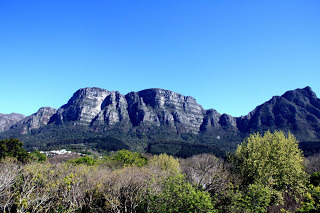
The extraordinary beauty of the city and how it sits on the oceanic front and sprawls into the valleys between the mountains was evident seen from the air as we descended in the rapidly darkening dusk. I had specifically asked for a window seat and not over a wing so as to have the chance to behold what I anticipated would be a gorgeous landing. But this was even more beautiful, as the changing colouring of the landscape conspired to make the scene mystical. First, the sun shone bright, almost dark red seemingly at the level of the plane. Soon it disappeared behind the western horizon sinking into the Atlantic Ocean leaving an orange glow in the sky. There were narrow vertical layers of high clouds that were gilded by the sun's last rays, while the lower level clouds hanging languidly over the valleys were turning dark. Below, the city lights were already on as the night had fallen on the ground. City suburbs and the vineyards of Stellenbosch and Kirstenbosch were connected by the pearly strings of roads on which car headlights were moving. The Table Mountain stood black surrounded by twinkling city lights. In the harbour off the coast a few large container ships were moored with all their lights glittering against the water.
It was indeed fully dark when we deboarded at the Cape Town international airport and walked across the tarmac to the terminal building. The Kulula flight from Johannesburg had taken two hours. I collected my bag and chose one of the several car rental companies almost at random based on name recognition and a vague recollection that they might contribute miles to one of my frequent flyer programs. The choice was good, as the efficient, friendly and very attractive lady of vaguely South Asian origin quickly dispatched me on my way with a very reasonably priced Chevy Spark equipped with a GPS navigation system. The latter was essential as I immediately had to navigate the airport exits and then the highways in this unfamiliar city, again getting used to driving on the left side of the road in a new car with a stick shift. I managed to get off the freeway at the right junction and entered the suburbs at Claremont and found my way to Newlands close to the Kirstenbosch vineyards on the northern side of the Table Mountain. The classic Vineyard Hotel & Spa had been recommended to me by my friend, Cape Town native David Simon, who now teaches development geography in London. I thoroughly looked forward to three days of R&R in between the conference that had just finished in Johannesburg and my next work engagement that would take me across the Indian Ocean over the coming weekend. Over dinner in New York a few weeks ago, David had virtually planned my visit highlighting all the necessary things I would have to do and see. I would have to find the right balance between doing that and just relaxing.
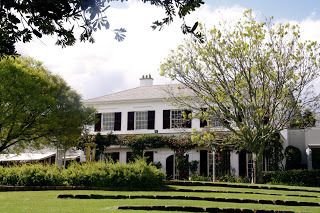
Cape Town is very different from Johannesburg in Gauteng, the business and government heart of South Africa. This town—often compared in its beauty to Rio de Janeiro—located in the southwestern tip of the African continent is much more relaxed and blessed with an extraordinary natural setting. When I woke up the following morning in my comfortable room with panoramic windows over the luxurious gardens of the hotel, it was drizzling and the Table Mountain was entirely covered in low hanging clouds. I knew then that today was the day to explore the city itself. The drive to the centre some 10 km away passed through clean and beautiful neighbourhoods with manicured lawns that gave way to the bustle of the city. Cape Town has a turbulent history since the first encounters between Europeans and native Africans here more than half a millennium ago. In the more recent past, the city has seen strife as a result of the unjust apartheid system that had legislated inequality between the races. The city also has slums, or townships, that are run down and lack infrastructure, but not on the scale of Gauteng where places like Soweto became symbols of the violent struggle against apartheid.
I started my visit at the Castle of Good Hope, built by the Dutch East India Company (VOC) in the late-17th century. It is an historical landmark that still houses the South African military, as well as the Military Museum. Its collections around the history of the Cape were to me very enlightening, starting as they were with the first encounters between European explorers and the African tribes living in the area. The very first European contact with the Khoi (or Khoikhoi) was in 1488 when the Portuguese explorer Bartolomeu Dias reached the Cape. A more intense period of European intrusions started with the rounding of the stormy waters of the Cape of Good Hope by Vasco da Gama in 1497, in a quest to find a sea route to India around Africa. Dias and da Gama's countryman Francisco d'Almeida sailed to the Cape in 1510, but his fate was less fortunate than that of his predecessors. Lured to the shore, he and more than 50 of his crew were slaughtered by the Khoi who surrounded the men. This setback was such that it took decades before the Europeans again landed in the area.
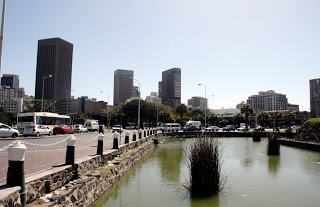
The Dutch were the first to permanently settle into the Cape area, which was administered by VOC from 1656 to 1795. During this period, large numbers of European immigrants of mostly Dutch, but also of German, French and other origins—who would become the Boers—arrived in the Cape and spread deeper into the country. Their hunger for agricultural land inevitably led to clashes with the pastoralist tribes like the Khoi (who were dubbed 'Hottentots' by the settlers) who were used to following their cattle roaming around according to seasons. A series of Khoi-Dutch wars ensued between 1659 and 1677.
Since those times, the Cape became a frontier in the struggle for control by successive European nations—Portugal, Holland, England, France—who all invariably fought the various native tribes, at times enlisting them to fight against the European rival of the day. One of the military brigades whose intriguing name caught my attention in the museum was the 'Bastaart Hottentotten,' which in 1781 consisted of Khoi soldiers recruited to serve under Dutch command.
The wars between the Europeans and Africans, however, were far from over. There would be nine Frontier Wars between 1779 and 1878 caused by the expansion of European settlements into the African lands. These wars were first fought mainly by the Dutch, but following the annexation of the Cape by Britain in 1806, they got drawn into the conflicts to protect the settlers.
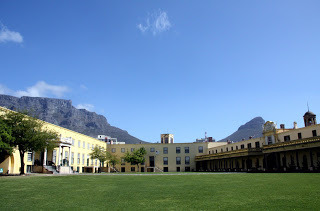
But it was really the competition between the Boers and the English that defined much of the 19th century history of South Africa. The Boer farmers started their Great Trek away from the British controlled areas moving inland in large numbers in the 1830s and 1840s. They also founded a number of republics, notably Transvaal and Orange Free State, under their own rule. The discovery of rich gold and diamond deposits some decades later resulted in gold rushes that again pitted the Boer settlers against the British who followed inland after the valuable minerals. Finally, in 1910 the Union of South Africa was formed following the British victory in the bloody Boer War of 1897-1903. The former Boer republics were merged into the union.
The castle also contains the William Fehr Collection consisting of artworks and furniture styles from the VOC days until the mid-19th century (Fehr was a South African businessman and art collector). I was entirely taken by the numerous paintings by artists such as Thomas Whitcombe (1760-1825), William John Huggins (1781-1845), William Syme (1824-1866) and John Thomas Baines (1820-1875) whose works depict powerful scenes in which the waters of the Cape are always turbulent. I stared for a long time at a Baines painting of a boat carrying newly arrived European immigrants—men, women and children—from a mother ship to the shore with waves churning around the hull. Irrespective of what one thinks about the consequent subordination of the native populations, one can only admire the courage and determination of the people moving to a new and strange continent under such conditions.
Race-based oppression was part of black South Africans' life much before apartheid, which institutionalized the separation of the races (whites, blacks, Asians and coloureds) following the electoral victory of the Boer National Party in 1948. The superb District Six Museum tells the story of one particular residential area in Cape Town. Established in 1867, the Sixth Municipal District used to be a mixed neighbourhood, originally of freed slaves, merchants, artisans, labourers and immigrants that became a target of successive white city administrations. Already in 1901, the Africans were forcibly resettled from the district that was located close to the city centre and port. As the wealthier parts of the population started moving out, District Six became increasingly marginalized. Despite the intentional neglect by the city authorities that ran down the place, it had a rich communal and cultural life with plenty of music and other forms of culture. A particular type of music that developed there was Langaarm played by dance bands inspired by early jazz. Using the degradation of the District Six as an excuse—and it was true that the area lacked sanitation and most of the houses were decrepit—the city government declared District Six as unsuitable for human habitation. In 1966, based on the Group Areas Act of 1950, District Six was declared a White Group Area and the forcible removal of its 60,000 inhabitants was completed by 1982 when all the buildings were bulldozed to make way for new construction for whites. The museum's historical collections, including photographs and audiovisual recordings, show in grim detail the timeline of this brutal process.
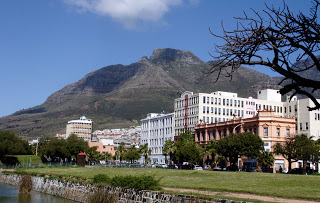
Following this quick immersion in South African history, I needed a walk to absorb all the information swirling in my brain and to sort out the often confusing timeline of events. The spring weather was fresh and I walked pass the College of Cape Town on the walking street where groups of students—black, white and mixed race—sat smoking under the trees, and continued to the City Hall square where I had parked. Reaching my car, I saw two young African men approaching me from opposite directions. Both turned out to be unofficial parking attendants who looked after the safety of the vehicles left on the square. I recognized one of them, a tall fellow with a bright smile under his woollen cap, as the one who had been there when I arrived. Consequently, I passed the 10 rand note to him. This resulted in an argument between the two and I saw the boys scuffle as I drove away towards my next stop.
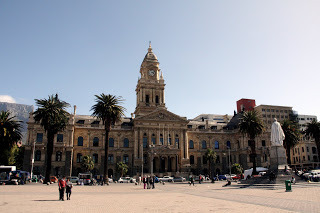
Long Street is to Cape Town what the Village (or today Brooklyn's Williamsburg) is to New York, a mixed and hip neighbourhood with alternative types of shops, ethnic restaurants and bars. I spent the following hours browsing in excellent second hand bookstores (including the classic Clarke's Bookshop, which has been around since 1956) and music shops, before settling down on the second floor terrace of the 'Neighbourhood' bar with a badly needed pint of Castle. In this late-afternoon hour the place was starting to fill up. Opposite from my still empty table on a tall stool sat a beautiful young black woman who was soon joined by two white chaps who had the air of being designers or perhaps theatre people. In this joint, young white waiters happily served a clientele whose skin colours reflected a wide scale of hues. As the crowd increased, I shared my table with a group of cheerful young Africans, two boys and three girls. It was happy hour and the kids were getting two-for-one cocktails. I clinked my glass with theirs and let them have the whole table after I downed my second pint.
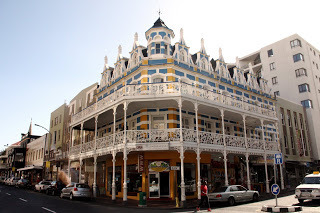
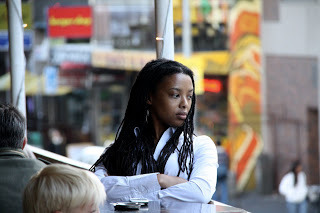
The following morning the sky was clear and iconic shape of Table Mountain stood free of clouds outside of my window. I programmed the GPS navigator, which was a blessing as the route to the seemingly nearby mountain turned out to be complicated, involving a rather long drive on the freeway, then heading up steep city streets before reaching a winding road that leads halfway up the mountain to the ropeway (or aerial cableway, as it is officially called). Although it was a Friday, the place was crowded and I had to leave the car several hundreds of metres from the entrance. Luckily I had bought the cableway ticket online so I did not have to wait in the queue. The wait for the ride up was quick as there are two gondolas that move up and down the cables in opposite directions. I took a deep breath and tried to calm my nerves as I stepped into the gondola. I must confess that riding in a small cabin suspended from a cable tens of metres above a steep mountainside makes me nervous. It didn't help that this particular cabin was designed to rotate throughout its five-minute (it felt much longer) ride to the top at 1,067 metres. En route I could see a group of climbers heading to the top the hard way, clinging to the vertical rock face aided with little equipment.
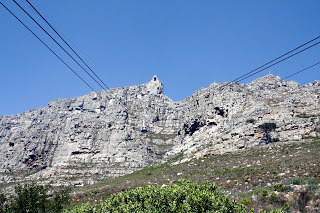
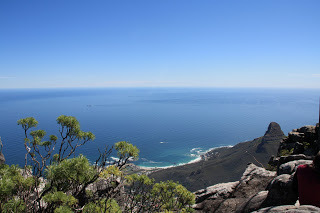
From the top the view was magnificent far over the city and its harbour. Robben Island, that houses the prison where Nelson Mandela was held for 27 years alongside other leaders of the African National Congress opposing the apartheid government, sat in the bay like a southern Alcatraz. To the south, beyond the mountains, one could see the place where the Atlantic and Indian Ocean meet. The mountain itself is a natural wonder: a 3-km long plateau of sandstone with an elevation variation of only 19 metres. Its nearly treeless and rocky expanse hides a rich biodiversity. In particular its flora is unique, consisting of endemic 'fynbos' ('delicate bush' in Afrikaans) vegetation. Fynbos, threatened by erosion, fires and human impact, consists of four primary plant groups: proteas (large broad-leafed shrubs), ericas (low-growing shrubs), restios (thin reed-like plants) and geophytes (bulbs). Due to its uniqueness and the rich variety of almost 1,500 plant species found there, the Cape Floristic Region has been declared a biodiversity hotspot and Table Mountain is recognized as a World Heritage Site. Although the fauna on this rough windswept plateau is less abundant, there are still several species of rodents, snakes, lizards, frogs and other animals who call Table Mountain home. Numerous birds ranging from smaller thrushes, bulbuls and doves to buzzards and eagles are found on the mountain. As we descended, I observed a pair of black eagles soaring majestically across the sky lifted by the air currents flowing up the hillside.
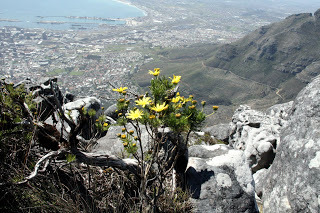
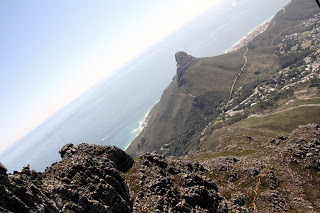
I drove south on the road that lines Western Cape. The ocean to my right glimmered brightly. After a while I entered the Chapman's Peak Drive, a 9-km toll road that winds in between the hillside and the shining sea through some of the most stunning scenery I've ever seen. Unfortunately, it was virtually impossible to stop and take photos without endangering the traffic. I accepted this fact with some regret and continued the drive until I reached the extension of the Table Mountain National Park at the southern tip of the peninsula between the Atlantic Ocean and False Bay to the east. The land has a barren beauty accentuated by the rocky beaches that disappear into the sea. I reached the legendary Cape of Good Hope, the southwestern-most point on the continent of Africa. It was obvious why it had posed a challenge for early navigators and had become the site of many a shipwreck over the centuries. Even on this beautiful and relatively calm spring day, the sea was churning and waves struck the rocks with mighty force splashing water high into the air. Bartolomeu Dias originally named this the Cape of Storms (Cabo das Tormentas) but the Portuguese king changed this to Cape of Good Hope (Cabo da Boa Esperança). Never having actually faced the force of the sea at the Cape, the king only saw the hope of his fleet reaching the riches of the east through this route.
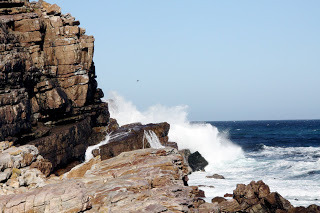
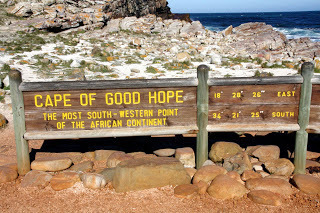
As I was relating these thoughts to the historical facts I had learned the day before, the place was suddenly invaded by several large tourist buses. Out poured tens of young Africans screaming with delight at the gorgeous sight that awaited them. They quickly spread around the beach and lined up to take each other's photos at the wooden sign that declared the longitude and latitude of our location. Many of the girls were dressed in short skirts and light blouses that seemed to provide inadequate cover against the strong wind gusting from the open ocean, but this didn't seem to quell their enthusiasm.
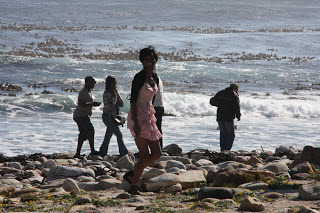
I decided it was time to continue my journey and head to Cape Point occupying the eastern fork of the peninsula. On the shore three ostriches were grazing, their silhouettes against the blue of the sea—an unlikely sight. There were signs posted warning about the pesky baboons, but I was not bothered by any. Cape Point was equally or more crowded than the commercially undeveloped Cape of Good Hope. Here there was a large parking lot lined with shops where the walkway up towards the lighthouse on the hilltop began. The elevation was much higher here and the views over the two oceans very beautiful.
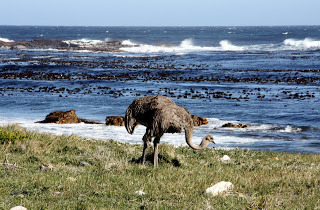
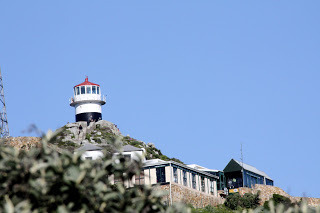
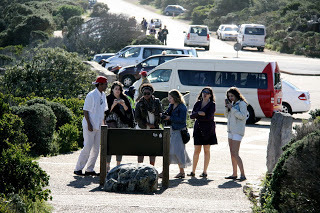
My return route went north on the coast of False Bay. I had spent so much time admiring the spot where the waters of the two mighty oceans merge that I was now very conscious of the time. I definitely wanted to get to Boulders Beach while it was still light. Here on the east coast of the peninsula the road was already darkened by the shadows of the hills to my left, although the sun was still relatively high above the horizon. I stepped on the gas to the extent I could safely do on this unfamiliar winding road. Passing Simon's Town, I arrived at Boulders Beach just after 5 pm. Here, the daylight would still linger for a good hour or more, although its warm yellow glow already reflected the sun's position low on the western sky. I started walking on the small road parallel to the beach, which then turned into a wooden walk bridge across coastal bushes. That's where I detected the first penguins. They were small, standing or lying down among the bushes; not a habitat that one immediately associates with these birds. The Boulders Beach – Simon's Town area is host to the northern-most colony of penguins in the world.
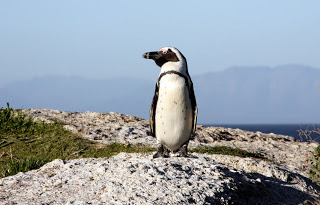
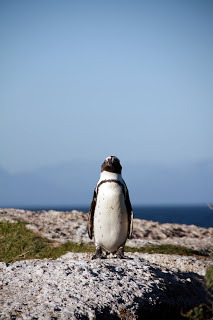
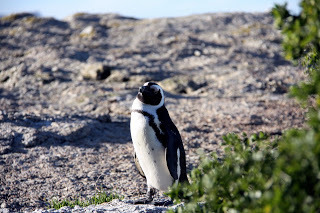
A bit further on, the bushes gave way to bare rocks that descended into the bay. This was more like it, I thought. I found penguins basking in the sun on these rocks, their white and black appearance dignified in all its bowling pin –like roundness. There were lone males standing still and proud against the wind and there were small groups lying on the rocks. Many were in couples, with the female standing beside her male, sometimes grooming him. Occasionally they would peck each other tenderly. A lovely scene against the most beautiful natural setting. A lone white lighthouse stood in the middle of the bay. There was a group of kayakers paddling among the boulders that must have given the name to the community. There were also seabirds other than the flightless penguins: gulls were coasting in the wind; a goose family with fluffy chicks was determinedly heading somewhere; a handsome white heron stood on a rock just off the shoreline. Just behind on the gently sloping hillside stood the idyllic small town of Boulders Beach with its white houses and romantic little restaurants. What a lovely place to live one's life, I thought. Signs warned motorists to look under their vehicles for penguins before starting their engines.
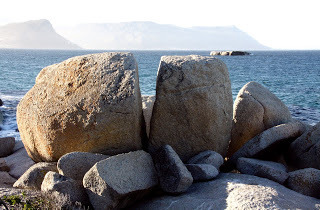
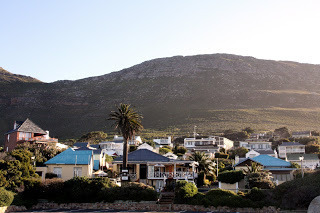
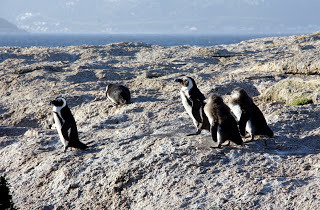
I had seen many such beautiful settlements along the coastal road today. In Cape Town itself, there were fabulous neighbourhoods facing the blue Atlantic that were as clean and white as their inhabitants (or at least the absolute majority of them). Seventeen years after the arrival of democracy in South Africa, political equality hadn't translated into economic equality. In fact, the income differences had actually risen. Despite the emergence of a black elite and a growing middle class, most Africans were still poor and worked in manual labour or lower service positions, if they were lucky enough to have a job at all. Driving to the airport the following day, I saw a large township next to the highway. It was an entirely unplanned settlement some ten kilometres outside of the city where presumably most of its inhabitants sought employment. The small houses were built with corrugated iron and were immensely densely packed leaving just narrow unpaved lanes in between. At the airport, I talked with a shoeshine man while waiting for the departure of my flight back to Johannesburg. Having discovered a sympathetic ear, he opened up about the hardships of life. He was lucky, in relative terms, to have a job at the airport relatively close to the townships. But the job paid a pittance and it was virtually impossible to survive on the income. And there was little hope for anything better. A bitterness came through in his voice.
South Africa's development after the democratic transition has been positive and first of all peaceful, thanks largely to the wisdom of Nelson Mandela and his associates, like Archbishop Desmond Tutu, who understood that South Africa had to continue on its multiracial path and put the painful inequalities and injustices behind. But one had to wonder at the patience of the people who had seen so little improvement in their lives despite the promise of majority rule, while they saw a minority—no longer determined solely on the colour of one's skin—thrive and grow rich. Something must be done about the growing gap in standards of living lest the multitude left behind lose its patience and take matters into its own hands. In that case, everyone would lose and the regional superpower could no longer be a model for its neighbours.
Published on October 02, 2011 15:26
September 21, 2011
Development with growing inequalities: Johannesburg
"The murder rate is down to some 15,000 per year—and they're proud of it." This was Indran speaking as we were driving on the highway from Sandton in northern Johannesburg towards Pretoria past some areas that were not quite as nice as the sunny suburb. At each junction there were men selling anything between bath toys to paper towels to the passing cars. All of the men were black. Indran clarified: "Of course it's progress. The murder rate used to be 30,000 a year just in the 1990s. But it's still pretty high for a nation of only some 50 million people!" According to him, class had replaced race as the new distinguishing factor in South Africa, a country with one of the highest rates of inequalities in the world. And there was a lot of alcohol abuse, which led to aggression and many other problems. Having consumed adequate quantities of good South African wine with him over the past three nights, I knew Indran was no prude. His judgement was a factual assessment of what was happening. As Deputy Director-General of the country's Public Service Commission, a serious watchdog, he knew what he talked about.
We had just spent some days in an international conference that our respective offices co-organized around the topic of national evaluation capacity and how evaluation can be used to enhance accountability in public administration. We organized the conference in Sandton at the oddly named sprawling hotel complex Balalaika. Sandton is a nice place, perfectly safe to walk around along its clean streets. Even the stalls selling African trinkets around Maude Street, across from Deutsche Bank and HSBC head offices, are neat and orderly. Like in many other places where the original city centre has become too dangerous and unruly, a new centre has evolved on the outskirts where things are kept more under control (Gigiri with its Village Market outside of Nairobi comes readily to mind).
On Sunday, I walked over to the Nelson Mandela Square, a huge complex of shops and restaurants that would put any American or European mall at shame with its style and sophistication. At the centre of the large square surrounded by tempting terraces serving food and drinks stands a six-meter tall statue of Nelson Mandela. On this Sunday, a live band was playing smooth jazz and bossa nova on the balcony of a Thai restaurant just behind the great leader's bronze head. Talk about globalization!
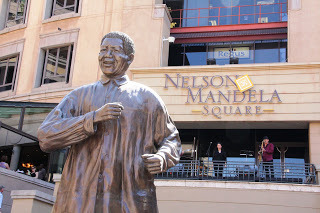
South Africa's divided history is equally well-known as it is brutal. The conservative Dutch settlers moved into the Cape of Good Hope already in the mid-1600s creating a society where time had stopped for three centuries. They started spreading across the southern cone of the continent through their Great Trek of 1836 getting into conflict with pastoral tribes herding their cattle in the areas the Boers wanted to settle in. Then there was the gold rush of the late-19th century and the ensuing Anglo-Boer War of 1899-1902. South Africa was contested land between the blacks and the whites, between the Boers and the British (and before that the fight included the Portuguese, the French and the Dutch, while the alliances constantly changed), and between different African population groups (who also were occasionally recruited to support one side or the other).
The Union of South Africa was finally formed in 1910 uniting Boer and British controlled areas, soon restricting black people to specific reservations. The official policy of racial discrimination, apartheid, was finally formalized legally following the electoral wins (of course, only the whites had the vote) by the National Party in 1948. What followed was a decades-long period of systematic discrimination and racial hatred that only ended when Nelson Mandela, the leader of the banned African National Congress (ANC), was released from jail where he had spent 27 years by 1990, and then democratically elected as the first black President of the Republic of South Africa in 1994. Mandela, now 93, became an iconic figure, perhaps the most admired leader in the world, by his visionary leadership, clear thinking and braveness. With associates, such as Archbishop Desmond Tutu, he made the case for reconciliation, and against all odds was able to avoid major civil unrest or bloodshed in post-apartheid South Africa.
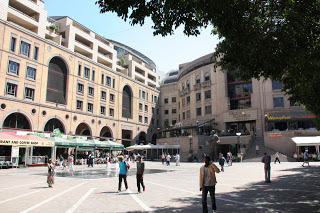
Mandela stepped down from the presidency in 1999 after just one term and nobody can blame him for giving up official duties too early. He clearly had done more than anyone could reasonably expect from one individual. Furthermore, he had seen so many African liberation leaders become 'Big Men' and never voluntarily leave office. In all fairness, there are a few exceptions amongst the first generation of post-colonial leaders, such as Tanzania's Mwalimu ('Teacher') Julius Nyerere and Zambia's Kenneth Kaunda. Regretfully, both had largely run down the economies of their countries, not through self-aggrandisement but through misguided economic policies; both nevertheless achieved 'elder statesman' status by gracefully withdrawing when the time came.
The worst remaining offender is the leader of Zimbabwe, South Africa's neighbour, Robert Mugabe. When he led his country, then Northern Rhodesia, to independence in 1980 after a prolonged civil war with the privileged white settlers, Mugabe was seen as a freedom fighter with serious ideals and credentials. Alas, history has proven otherwise and the ruthless old man has not hesitated to use extreme violence to kill and intimidate his own people who have dared to protest the economic ruin and starvation that his policies have caused. Recent reports indicate that the now 87-year-old dictator has been diagnosed with prostate cancer and has about 1.5 years to live. His departure will solve a problem that has been an embarrassment to South Africa, as the bigger neighbour has not been able to influence Mugabe to step down or at least change his policies (the mediation efforts of Mandela's successor Thabo Mbeki were widely regarded as half-hearted).
Unfortunately, ANC leadership after Mandela has not been equally wise as Mandela was. The political leaders of the party that dominates South Africa have assumed features that Mandela wanted expressly to avoid. To him, it was important to ensure the independence of the judiciary and freedom of press. His heirs have increasingly succumbed to the temptation to control these sometimes inconvenient institutions.
At the time of the shift from the first majority president to the next, the Republic of South Africa was developing surprisingly harmoniously, given the extent of hatred, violence and discrimination of past decades, and experienced a steady economic growth of 5-6% annually year after year. The past racial injustices were being acknowledged and addressed to the extent possible and a democratic society was being built (although in all honesty, Mandela and Tutu's 'reconciliation' were a compromise and seen by many as not dealing adequately with past injustices, as explained by Alec Russell in his superb new book, After Mandela: The Battle for the Soul of South Africa).
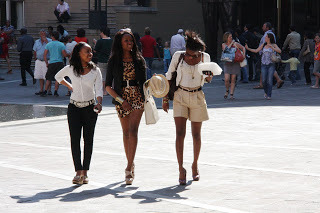
The fundamentals of the economy are still quite strong, thanks largely to the rich mineral resources (including diamonds, gold and many other minerals that are in high demand) that have protected the country against the global economic crisis. Mandela also succeeded in avoiding an exodus of skilled professionals, most of whom were white or Asian, experienced by other countries, such as Zimbabwe. Nevertheless, poverty is rampant amongst people, while a minority is getting richer by the day The UN ranks South Africa as a middle-income country with a medium level of human development based on health, education and income statistics. In 2010 South Africa ranked 110th in human development amongst the 169 countries ranked. What brings down South Africa's ratings are a low life expectancy of just 52 years (largely due to the HIV/AIDS epidemic) and inequality in opportunities to education, health and economic development. The mostly black underclass still suffers from powerlessness, with unemployment rates of some 30%. Russell quotes a 2008 employment report by the United Association of South Africa, a trade union, that found that at that time, 14 years after the democratic shift, whites' incomes on average were 450 times higher than those of the blacks—and economic inequalities had actually been rising, despite the increasing number of blacks entering the middle class. It is not saying that the different groups would not have equal access under the law. It's more like in the USA: opportunities for liberty and the pursuit of happiness are limited for a large number of people by structural constraints.
Of course, affirmative action was necessary after decades of legislated and harshly enforced racial oppression. The whites and the Asians are still doing fine, largely thanks to Mandela's insistence on national reconciliation. I certainly have no intention to imply that all black leaders would be corrupt or incompetent. There is a highly professional black middle class, steadily growing, with a strong role in both the private sector as well as public administration. One good example is Mashwale Diphofa, the Director-General of the Public Service Commission (and Indran's boss). With a strong ethical backbone, high professional skills and political savvy, Mash is a model that many officials from the so called 'developed' countries could emulate. What's more to emulate is that the stylish and smooth man knows his music. I was amazed how we could discuss jazz together after we had witnessed an exciting dance and music performance at Balalaika (no Russian triangular string instruments included).
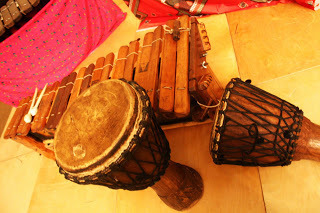
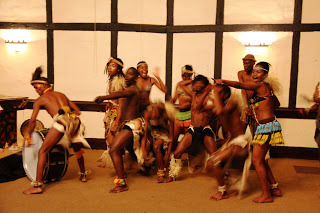
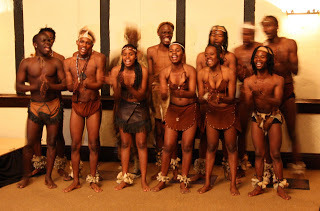
One of the greatest challenges to South Africa is the high prevalence of HIV infection and consequently AIDS. The disease affects very much the middle class and professionals in their prime who would be so badly needed to contribute to the economy and to enhance the performance of the civil service. One evening over some excellent local Pinotage, Indran told me how he had recently lost an assistant, a young and highly capable woman in the Office of the Public Service Commission. Initially, one does not notice anything and for a long while the only visible change is that the person starts losing weight (not necessarily a bad sign in this country of many large people). But at some point of time, after months, it starts to become evident that something is seriously wrong. The victim becomes lethargic and loses energy. Then the cheeks sink in and a special look appears on the person's face. It's like her eyes had gotten bigger and they just stare out of the increasingly skull-like visage. After that, the end often comes quickly.
The topic of AIDS has been a political hot potato in South Africa, to a large extent for political reasons. Initially Mandela attempted to address it, but faced so much resistance from his audiences that even he had to make a calculation of the trade-offs between pushing the issue and political survival. The societal forces were just dead against him. Regular people would accuse him of encouraging promiscuity as he advocated for condom use, while the truly promiscuous politicians and power-brokers certainly did not want to hear about the topic. Mandela's successor as President, Thabo Mbeki, notoriously questioned the causal linkage between HIV and AIDS. The current President Jacob Zuma was accused of (and acquitted from ) raping a daughter of a political ally—more than 30 years his junior—she herself an HIV positive AIDS activist. Zuma has some twenty children from five wives. In the meantime, this conspiracy of silence continues to kill people and take a toll on the very development of the society.
After somewhat complicated shortcuts Indran had followed upon instructions from the GPS, we were approaching Lanseria International Airport constructed only years ago in the middle of the rolling hills between Johannesburg and the capital Pretoria. Indran turned the BMW to an apparent entrance to the airport and we suddenly hit a checkpoint with two uniformed guards. One of the guards, a friendly black woman, approached us and explained that this was a special entrance and one needed a permit to pass through here. The alternative was to continue on the main road and go through the main gate, but that would be another 19 km. We opted for getting the permit, which was free but only obtainable by driving to a trailer parked some way at the side. There we found two more uniformed officers, one resting his head on his arms apparently asleep in the afternoon heat pounding on the container they called office. Paperwork was filled for both of us by the more alert officer, while the sleepy one took my passport and studied it at length, holding each page against the light wondering at the perforations and watermarks that were supposed to make it counterfeit-proof, before handing it back to me. The alert one asked me whether I was carrying any fire arms. "Not today," I responded, but wondered whether this was a relevant concern upon entering an airport ("Oh yeah, they're obsessed with firearms," responded Indran casually).
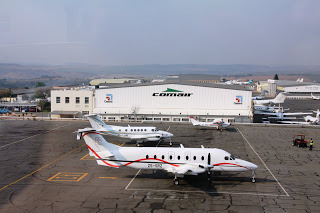
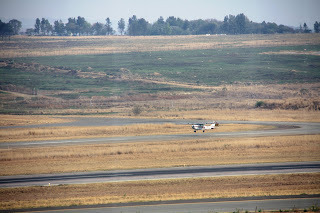
Off we sped and after several twists and turns around airline offices, hangars and cargo areas we reached the spanking new terminal building. From there on, everything was smooth as silk. While I sat on the observation deck waiting for the departure of my Kulula jet towards Cape Town, I considered the balance between the benefits of keeping four uniformed personnel filling in forms for non-fee entry permit to the premises vs. the need for expediency to attract more passengers to use this new airport instead of the established O.R. Tambo International Airport serving the twin cities. Clearly, this was an employment scheme and, as such, it had much merit. At least these guards were proudly wearing their uniforms and receiving salaries, thus not entering the ranks of the unemployed, desperate and potentially violent. To me, there is great value in that for human dignity and contributions to society.
I also pondered what the word 'international' actually referred to in the case of the Lanseria airfield where tiny Cessna and Piper aircraft kept landing and taking off while I sipped my cool drink.
We had just spent some days in an international conference that our respective offices co-organized around the topic of national evaluation capacity and how evaluation can be used to enhance accountability in public administration. We organized the conference in Sandton at the oddly named sprawling hotel complex Balalaika. Sandton is a nice place, perfectly safe to walk around along its clean streets. Even the stalls selling African trinkets around Maude Street, across from Deutsche Bank and HSBC head offices, are neat and orderly. Like in many other places where the original city centre has become too dangerous and unruly, a new centre has evolved on the outskirts where things are kept more under control (Gigiri with its Village Market outside of Nairobi comes readily to mind).
On Sunday, I walked over to the Nelson Mandela Square, a huge complex of shops and restaurants that would put any American or European mall at shame with its style and sophistication. At the centre of the large square surrounded by tempting terraces serving food and drinks stands a six-meter tall statue of Nelson Mandela. On this Sunday, a live band was playing smooth jazz and bossa nova on the balcony of a Thai restaurant just behind the great leader's bronze head. Talk about globalization!

South Africa's divided history is equally well-known as it is brutal. The conservative Dutch settlers moved into the Cape of Good Hope already in the mid-1600s creating a society where time had stopped for three centuries. They started spreading across the southern cone of the continent through their Great Trek of 1836 getting into conflict with pastoral tribes herding their cattle in the areas the Boers wanted to settle in. Then there was the gold rush of the late-19th century and the ensuing Anglo-Boer War of 1899-1902. South Africa was contested land between the blacks and the whites, between the Boers and the British (and before that the fight included the Portuguese, the French and the Dutch, while the alliances constantly changed), and between different African population groups (who also were occasionally recruited to support one side or the other).
The Union of South Africa was finally formed in 1910 uniting Boer and British controlled areas, soon restricting black people to specific reservations. The official policy of racial discrimination, apartheid, was finally formalized legally following the electoral wins (of course, only the whites had the vote) by the National Party in 1948. What followed was a decades-long period of systematic discrimination and racial hatred that only ended when Nelson Mandela, the leader of the banned African National Congress (ANC), was released from jail where he had spent 27 years by 1990, and then democratically elected as the first black President of the Republic of South Africa in 1994. Mandela, now 93, became an iconic figure, perhaps the most admired leader in the world, by his visionary leadership, clear thinking and braveness. With associates, such as Archbishop Desmond Tutu, he made the case for reconciliation, and against all odds was able to avoid major civil unrest or bloodshed in post-apartheid South Africa.

Mandela stepped down from the presidency in 1999 after just one term and nobody can blame him for giving up official duties too early. He clearly had done more than anyone could reasonably expect from one individual. Furthermore, he had seen so many African liberation leaders become 'Big Men' and never voluntarily leave office. In all fairness, there are a few exceptions amongst the first generation of post-colonial leaders, such as Tanzania's Mwalimu ('Teacher') Julius Nyerere and Zambia's Kenneth Kaunda. Regretfully, both had largely run down the economies of their countries, not through self-aggrandisement but through misguided economic policies; both nevertheless achieved 'elder statesman' status by gracefully withdrawing when the time came.
The worst remaining offender is the leader of Zimbabwe, South Africa's neighbour, Robert Mugabe. When he led his country, then Northern Rhodesia, to independence in 1980 after a prolonged civil war with the privileged white settlers, Mugabe was seen as a freedom fighter with serious ideals and credentials. Alas, history has proven otherwise and the ruthless old man has not hesitated to use extreme violence to kill and intimidate his own people who have dared to protest the economic ruin and starvation that his policies have caused. Recent reports indicate that the now 87-year-old dictator has been diagnosed with prostate cancer and has about 1.5 years to live. His departure will solve a problem that has been an embarrassment to South Africa, as the bigger neighbour has not been able to influence Mugabe to step down or at least change his policies (the mediation efforts of Mandela's successor Thabo Mbeki were widely regarded as half-hearted).
Unfortunately, ANC leadership after Mandela has not been equally wise as Mandela was. The political leaders of the party that dominates South Africa have assumed features that Mandela wanted expressly to avoid. To him, it was important to ensure the independence of the judiciary and freedom of press. His heirs have increasingly succumbed to the temptation to control these sometimes inconvenient institutions.
At the time of the shift from the first majority president to the next, the Republic of South Africa was developing surprisingly harmoniously, given the extent of hatred, violence and discrimination of past decades, and experienced a steady economic growth of 5-6% annually year after year. The past racial injustices were being acknowledged and addressed to the extent possible and a democratic society was being built (although in all honesty, Mandela and Tutu's 'reconciliation' were a compromise and seen by many as not dealing adequately with past injustices, as explained by Alec Russell in his superb new book, After Mandela: The Battle for the Soul of South Africa).

The fundamentals of the economy are still quite strong, thanks largely to the rich mineral resources (including diamonds, gold and many other minerals that are in high demand) that have protected the country against the global economic crisis. Mandela also succeeded in avoiding an exodus of skilled professionals, most of whom were white or Asian, experienced by other countries, such as Zimbabwe. Nevertheless, poverty is rampant amongst people, while a minority is getting richer by the day The UN ranks South Africa as a middle-income country with a medium level of human development based on health, education and income statistics. In 2010 South Africa ranked 110th in human development amongst the 169 countries ranked. What brings down South Africa's ratings are a low life expectancy of just 52 years (largely due to the HIV/AIDS epidemic) and inequality in opportunities to education, health and economic development. The mostly black underclass still suffers from powerlessness, with unemployment rates of some 30%. Russell quotes a 2008 employment report by the United Association of South Africa, a trade union, that found that at that time, 14 years after the democratic shift, whites' incomes on average were 450 times higher than those of the blacks—and economic inequalities had actually been rising, despite the increasing number of blacks entering the middle class. It is not saying that the different groups would not have equal access under the law. It's more like in the USA: opportunities for liberty and the pursuit of happiness are limited for a large number of people by structural constraints.
Of course, affirmative action was necessary after decades of legislated and harshly enforced racial oppression. The whites and the Asians are still doing fine, largely thanks to Mandela's insistence on national reconciliation. I certainly have no intention to imply that all black leaders would be corrupt or incompetent. There is a highly professional black middle class, steadily growing, with a strong role in both the private sector as well as public administration. One good example is Mashwale Diphofa, the Director-General of the Public Service Commission (and Indran's boss). With a strong ethical backbone, high professional skills and political savvy, Mash is a model that many officials from the so called 'developed' countries could emulate. What's more to emulate is that the stylish and smooth man knows his music. I was amazed how we could discuss jazz together after we had witnessed an exciting dance and music performance at Balalaika (no Russian triangular string instruments included).



One of the greatest challenges to South Africa is the high prevalence of HIV infection and consequently AIDS. The disease affects very much the middle class and professionals in their prime who would be so badly needed to contribute to the economy and to enhance the performance of the civil service. One evening over some excellent local Pinotage, Indran told me how he had recently lost an assistant, a young and highly capable woman in the Office of the Public Service Commission. Initially, one does not notice anything and for a long while the only visible change is that the person starts losing weight (not necessarily a bad sign in this country of many large people). But at some point of time, after months, it starts to become evident that something is seriously wrong. The victim becomes lethargic and loses energy. Then the cheeks sink in and a special look appears on the person's face. It's like her eyes had gotten bigger and they just stare out of the increasingly skull-like visage. After that, the end often comes quickly.
The topic of AIDS has been a political hot potato in South Africa, to a large extent for political reasons. Initially Mandela attempted to address it, but faced so much resistance from his audiences that even he had to make a calculation of the trade-offs between pushing the issue and political survival. The societal forces were just dead against him. Regular people would accuse him of encouraging promiscuity as he advocated for condom use, while the truly promiscuous politicians and power-brokers certainly did not want to hear about the topic. Mandela's successor as President, Thabo Mbeki, notoriously questioned the causal linkage between HIV and AIDS. The current President Jacob Zuma was accused of (and acquitted from ) raping a daughter of a political ally—more than 30 years his junior—she herself an HIV positive AIDS activist. Zuma has some twenty children from five wives. In the meantime, this conspiracy of silence continues to kill people and take a toll on the very development of the society.
After somewhat complicated shortcuts Indran had followed upon instructions from the GPS, we were approaching Lanseria International Airport constructed only years ago in the middle of the rolling hills between Johannesburg and the capital Pretoria. Indran turned the BMW to an apparent entrance to the airport and we suddenly hit a checkpoint with two uniformed guards. One of the guards, a friendly black woman, approached us and explained that this was a special entrance and one needed a permit to pass through here. The alternative was to continue on the main road and go through the main gate, but that would be another 19 km. We opted for getting the permit, which was free but only obtainable by driving to a trailer parked some way at the side. There we found two more uniformed officers, one resting his head on his arms apparently asleep in the afternoon heat pounding on the container they called office. Paperwork was filled for both of us by the more alert officer, while the sleepy one took my passport and studied it at length, holding each page against the light wondering at the perforations and watermarks that were supposed to make it counterfeit-proof, before handing it back to me. The alert one asked me whether I was carrying any fire arms. "Not today," I responded, but wondered whether this was a relevant concern upon entering an airport ("Oh yeah, they're obsessed with firearms," responded Indran casually).


Off we sped and after several twists and turns around airline offices, hangars and cargo areas we reached the spanking new terminal building. From there on, everything was smooth as silk. While I sat on the observation deck waiting for the departure of my Kulula jet towards Cape Town, I considered the balance between the benefits of keeping four uniformed personnel filling in forms for non-fee entry permit to the premises vs. the need for expediency to attract more passengers to use this new airport instead of the established O.R. Tambo International Airport serving the twin cities. Clearly, this was an employment scheme and, as such, it had much merit. At least these guards were proudly wearing their uniforms and receiving salaries, thus not entering the ranks of the unemployed, desperate and potentially violent. To me, there is great value in that for human dignity and contributions to society.
I also pondered what the word 'international' actually referred to in the case of the Lanseria airfield where tiny Cessna and Piper aircraft kept landing and taking off while I sipped my cool drink.
Published on September 21, 2011 22:47
September 4, 2011
Taming the Gods: Religion and Democracy on Three Continents, by Ian Buruma
In this short and reasoned treatise, Ian Buruma addresses a central issue of democracy, namely the separation of church and state, from a historical, social and political perspective.
The book is divided into three main parts. In the first, Full Tents and Empty Cathedrals, Buruma juxtaposes the experiences in Europe and in America, providing an insightful analysis of what separates—and unites—the old and the new continent, including the role of born-again evangelical Christians in American politics. His conclusion, perhaps surprisingly, is that the gulf between 'secular' Europe and more traditionally religious America is not as large as it often is made to be. Buruma writes: "Our histories are not the same and we have different notions of who we are. But everywhere people are trying to cope with the confusions of a fast-changing world by reaching for fixed—and quite often newly made up—identities based on race, religion, or national culture" (p. 46). This summarizes one of the main theses in the book: that religious fervor must be understood not in theological, but in social and political terms.
The second part of the book, Oriental Wisdom, turns attention to China and Japan. He draws parallels and explains differences in history that led to different outcomes. Buruma is particularly well versed in Japan's history since the Meiji Restoration through the pre-war years until today, and this knowledge translates into a clear analysis in this book, as well as several others by him. He provides an interesting analysis of Maoism in China and Emperor worship in Japan as examples where state and spiritual authority coincided. While religion today plays a smaller role in these East Asian countries, Buruma traces the rise of a variety of cults and other religious groups, such as the Falun Gong, to the spiritual vacuum left by the collapse of Maoism in China and the prohibition of political participation by the Chinese people. Similarly in Japan the focus on chasing economic prosperity has left such a vacuum.
The final part, Enlightenment Values, focuses on how Western liberal societies should deal with the rising multiculturalism in our societies. This is a particularly balanced and coherent section of the book. Buruma draws from well-known cases that have led to the Kulturkampf in Europe, over issues such as the cultural rights (to discriminate against women or for women to wear a veil) of immigrant groups in Europe against the demands for them to integrate into the host societies and their norms. It all boils down to a confrontation between those who defend anyone's right to stick to his or her culture of origin (with no consideration of its respect for host country values) vs. those (probably in the majority in Europe now) who want immigrants to integrate into the society. It is very interesting to follow Buruma's argumentation around the very difficult question between people's right to their own culture vs. respecting 'universal' – or at least those of the majority of people in the country – values of Enlightenment. This is a dilemma many liberals in the West face, torn between the values of freedom that we so cherish and the knee-jerk desire to respect others' cultural values, how much at cross-purposes they might be with ours. Buruma points out how it is often the same people (many of them left leaning intellectuals) who in the 1960s and 1970s defended Third World rights against Western (cultural) imperialism that now are most worried about the spread of illiberal values into Europe through immigration from poor countries. The comparisons between the different approaches towards immigrant groups taken by the UK, Holland and France is quite illuminating.
He discusses at some length problems related, especially, to the integration of Muslims (both immigrant and those born there) into the European society. One interesting example is the case of Ayaan Hirsi Ali, who by now is a talk show star in the US, who having overcome her challenges in the home country of Somalia and the morally relativist Holland now fights for the rights of Muslim women to break away from the oppression of their original culture. Another case that Buruma discusses at some length is that of Salman Rushdie who earned himself a fatwa for his book The Satanic Verses and had to go into hiding as a result.
Buruma draws a clear line against terrorists and religious fundamentalists who resort to violence. "The use of violence in a democracy, for whatever reason, can only be met with force," he states (p. 115). He recognizes that while religious orthodoxy and political extremism can be linked, they are not the same thing nor does one necessarily lead to the other. However, discussing the cases of Mohammed Bouyeri, the Dutch born son of Moroccan immigrants who killed the film maker Theo van Gogh in Amsterdam, and Mohammad Sidique Khan, leader of the 7/7 terrorists who bombed the London underground, Buruma traces their violent terrorism and 'religious awakening' to the isolation and cultural rootlessness they experienced in the European countries they were born into.
Buruma concludes convincingly that the separation of state and religion is quite essential in a democracy. A well functioning democratic society does not have to share the same social or religious values as long as everybody abides by the society's rules and laws. He also makes a valuable distinction between respecting other people, while not necessarily respecting their beliefs. "Liberal democracies are not well served by laws that limit free speech, such as laws against blasphemy or denying the Holocaust or the Armenian genocide," he writes, and continues "(T)here are ways, however, to respect the dignity of fellow citizens without recourse to the law" (p. 123).
Ian Buruma's book is fabulously erudite. The writing is stellar and lucid, anchored firmly in the writings of Enlightenment philosophers, such as Spinoza and Hume, as well as Tocqueville, Confucius and others. He gets to the heart of the matter without getting bogged down in unnecessary detail. Born in Holland from Dutch and British parents, Buruma spent a significant portion of his career in Japan and China. He now teaches at Bard College in New York. He is thus extraordinarily well placed to understand the historical and social situations in these countries located on three continents. He ends with paraphrasing Confucius: Let us leave the spirits aside, until we know how best to serve men.
The book is divided into three main parts. In the first, Full Tents and Empty Cathedrals, Buruma juxtaposes the experiences in Europe and in America, providing an insightful analysis of what separates—and unites—the old and the new continent, including the role of born-again evangelical Christians in American politics. His conclusion, perhaps surprisingly, is that the gulf between 'secular' Europe and more traditionally religious America is not as large as it often is made to be. Buruma writes: "Our histories are not the same and we have different notions of who we are. But everywhere people are trying to cope with the confusions of a fast-changing world by reaching for fixed—and quite often newly made up—identities based on race, religion, or national culture" (p. 46). This summarizes one of the main theses in the book: that religious fervor must be understood not in theological, but in social and political terms.
The second part of the book, Oriental Wisdom, turns attention to China and Japan. He draws parallels and explains differences in history that led to different outcomes. Buruma is particularly well versed in Japan's history since the Meiji Restoration through the pre-war years until today, and this knowledge translates into a clear analysis in this book, as well as several others by him. He provides an interesting analysis of Maoism in China and Emperor worship in Japan as examples where state and spiritual authority coincided. While religion today plays a smaller role in these East Asian countries, Buruma traces the rise of a variety of cults and other religious groups, such as the Falun Gong, to the spiritual vacuum left by the collapse of Maoism in China and the prohibition of political participation by the Chinese people. Similarly in Japan the focus on chasing economic prosperity has left such a vacuum.
The final part, Enlightenment Values, focuses on how Western liberal societies should deal with the rising multiculturalism in our societies. This is a particularly balanced and coherent section of the book. Buruma draws from well-known cases that have led to the Kulturkampf in Europe, over issues such as the cultural rights (to discriminate against women or for women to wear a veil) of immigrant groups in Europe against the demands for them to integrate into the host societies and their norms. It all boils down to a confrontation between those who defend anyone's right to stick to his or her culture of origin (with no consideration of its respect for host country values) vs. those (probably in the majority in Europe now) who want immigrants to integrate into the society. It is very interesting to follow Buruma's argumentation around the very difficult question between people's right to their own culture vs. respecting 'universal' – or at least those of the majority of people in the country – values of Enlightenment. This is a dilemma many liberals in the West face, torn between the values of freedom that we so cherish and the knee-jerk desire to respect others' cultural values, how much at cross-purposes they might be with ours. Buruma points out how it is often the same people (many of them left leaning intellectuals) who in the 1960s and 1970s defended Third World rights against Western (cultural) imperialism that now are most worried about the spread of illiberal values into Europe through immigration from poor countries. The comparisons between the different approaches towards immigrant groups taken by the UK, Holland and France is quite illuminating.
He discusses at some length problems related, especially, to the integration of Muslims (both immigrant and those born there) into the European society. One interesting example is the case of Ayaan Hirsi Ali, who by now is a talk show star in the US, who having overcome her challenges in the home country of Somalia and the morally relativist Holland now fights for the rights of Muslim women to break away from the oppression of their original culture. Another case that Buruma discusses at some length is that of Salman Rushdie who earned himself a fatwa for his book The Satanic Verses and had to go into hiding as a result.
Buruma draws a clear line against terrorists and religious fundamentalists who resort to violence. "The use of violence in a democracy, for whatever reason, can only be met with force," he states (p. 115). He recognizes that while religious orthodoxy and political extremism can be linked, they are not the same thing nor does one necessarily lead to the other. However, discussing the cases of Mohammed Bouyeri, the Dutch born son of Moroccan immigrants who killed the film maker Theo van Gogh in Amsterdam, and Mohammad Sidique Khan, leader of the 7/7 terrorists who bombed the London underground, Buruma traces their violent terrorism and 'religious awakening' to the isolation and cultural rootlessness they experienced in the European countries they were born into.
Buruma concludes convincingly that the separation of state and religion is quite essential in a democracy. A well functioning democratic society does not have to share the same social or religious values as long as everybody abides by the society's rules and laws. He also makes a valuable distinction between respecting other people, while not necessarily respecting their beliefs. "Liberal democracies are not well served by laws that limit free speech, such as laws against blasphemy or denying the Holocaust or the Armenian genocide," he writes, and continues "(T)here are ways, however, to respect the dignity of fellow citizens without recourse to the law" (p. 123).
Ian Buruma's book is fabulously erudite. The writing is stellar and lucid, anchored firmly in the writings of Enlightenment philosophers, such as Spinoza and Hume, as well as Tocqueville, Confucius and others. He gets to the heart of the matter without getting bogged down in unnecessary detail. Born in Holland from Dutch and British parents, Buruma spent a significant portion of his career in Japan and China. He now teaches at Bard College in New York. He is thus extraordinarily well placed to understand the historical and social situations in these countries located on three continents. He ends with paraphrasing Confucius: Let us leave the spirits aside, until we know how best to serve men.
Published on September 04, 2011 09:33
July 20, 2011
Helsinki Summer
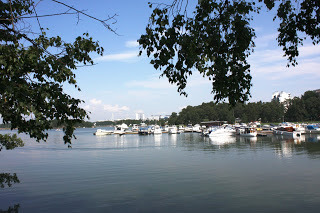
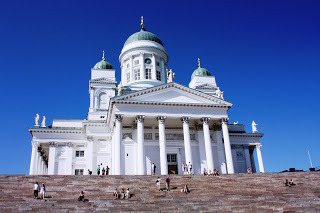
Helsinki, my old hometown, which I left more than half a lifetime ago, is a fantastic summer city. During the twelve days I just spent there, the temperature dropped below 25 degrees Celsius only during one day. At times, the heat and humidity were almost unbearable when the sun was burning down from a cloudless sky for almost 20 hours every day. Especially the nights were tough as none of the older buildings have air conditioning and the thick stone walls store heat during the day, which then radiates into the living quarters during night. I suppose the summer nights just are not meant for sleeping.
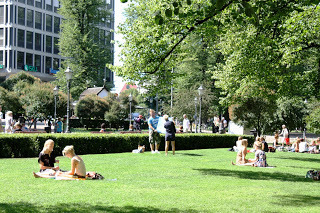
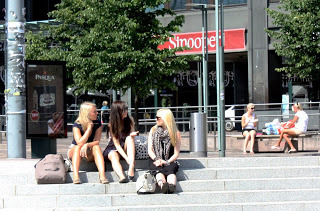
During days like these, the city is a true delight, with people strolling around languidly in their skimpy summer wear or lying down on the grass in the many parks. Even those having to work tend to take long lunch breaks in places like the Esplanade or the old market place, and then leave their offices in mid-afternoon to spend another day's worth of light evenings. Terraces seem to sprout everywhere in the city serving cold beer and cider to cool down the dehydrated denizens. Not to forget gin long drink—lovingly known as 'lonkero' (meaning tentacle) by the Finns. A readymade concoction consisting of gin and grapefruit soda invented for the 1952 Helsinki Olympics, lonkero will celebrate its 60th anniversary next year—still going strong! And for better or for worse, the Finns like their brews, which they on occasion consume in somewhat unreasonable quantities. At some 9.7 liters per capita annually, Finnish alcohol consumption falls in the international mid-range (for example, for USA the figure is 8.4 liters and for Russia 11 liters), but instead of sipping a glass of wine with our meals, the Finns have the tendency to down it all at once. Not even the high prices, which are rather striking for someone coming from outside of the euro zone, can dampen demand. (In fact, Finland has the dubious distinction of being overall the third most expensive country in Europe, after Norway and Switzerland.)
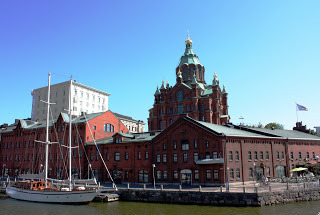
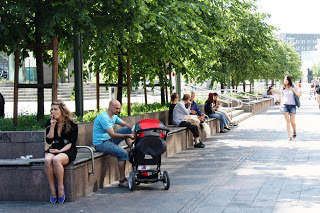
The Helsinki cityscape has changed considerably since my days there. For one, there has been a notable liberalization of entertainment policies. Restaurants can now stay open until early in the morning (except for the terraces, which must chase their customers indoors at 10 pm so that they don't disturb the sleep of nearby residents) and they now can—and many do—import their own wines directly from the producing countries. Although not exactly legal, the police do not interfere when people walk around the city or rest in the parks with their own drinks as long as they do not cause any public disturbance.
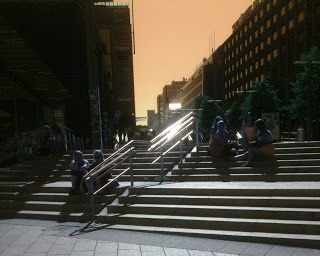
Another major change in the past couple of decades has been the rapid internationalization of the city. Tourists have of course visited the country also before, but no t in these numbers. Today, walking around Helsinki one can hear a multitude of languages, not only those of the neighboring Scandinavian countries, Russia and Estonia, but virtually any imaginable European and non-European lingo. There are hordes of East Asians, most likely thanks to the national airline, Finnair, which offers the best gateway from Europe to Asia, with daily flights to several destinations in Japan, China, Thailand, India and elsewhere. I stayed in my brother's apartment and each morning I would wake up to huge tourist buses hauling visitors to the adjacent Temppeliaukio church, famous for having been built inside a rock.
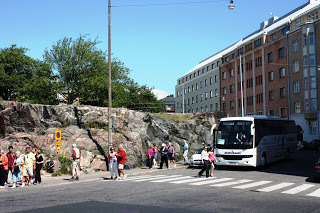
There are also unprecedented numbers of foreign residents in Finland. Many, like Victor who hails from Brazil and married my niece Jenni, have come for personal reasons. Others, in waves of refugees: Chileans after the 1973 coup that killed democratically elected president Salvador Allende and ushered in a period of military dictatorship; then Vietnamese boat people; later Somalis fleeing the chaos in their fractured homeland for safety or for economic reasons; next Libyans, whom Finland has pledged to the United Nations to accommodate. The opponents of Finland's joining the European Union in 1995 attempted to scare voters that our pure country would be overrun by foreigners because of our strong economy and social security. Such a massive invasion, naturally, never materialized. The Portuguese sardine fishermen or the unemployed Italian autoworkers never moved up to Finland to seek employment with Nokia or the forest industry. The long winters and the thorny language, added to the Europeans' general reluctance to move outside of their native comfort zone, took care of that. Nevertheless, immigration has steadily increased and with it tensions between the native Finns and the newer inhabitants. One group that is now conspicuous in the city consists of Romanian gypsies who beg professionally on the streets. Their presence has divided the citizenship into the liberals who defend their human rights and wish to extend the social benefits to them, and the average guy who finds them to be a general nuisance.
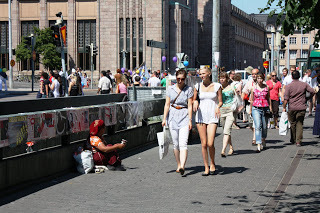
My friend Ilkka who works in forensic science had been briefed by the Helsinki chief of police who had provided some statistics. Out of the top 20 most wanted criminals in Finland, only one is currently a foreigner, compared with 17 in Sweden. This is, however, rapidly changing and, according to the chief, the next wave of dangerous foreign criminals has already entered the country. Twenty years ago, 17 of the 20 most wanted in Sweden would have been Finns, I pointed out.
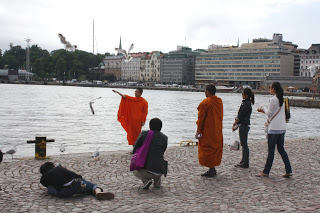
Tensions created by the new foreigners in Finland, as well as the plans to bail out Greece and other EU countries whose economy has gone south (even further south, that is, from the Finnish point of view), led to stunning electoral results earlier in the spring. A xenophobic protest party, True Finns, emerged as the largest party in the parliament. This Finnish version of the Tea Party sees the European Union as the biggest threat to the country's sovereignty and way of life. Now, in the Finnish political landscape there are numerous parties—some of which survive only one electoral cycle—and no one will ever gain the majority of the vote. In fact, there are several, including the conservative National Coalition Party, the Social Democrats, the rural oriented Centre Party and, now, the True Finns, that all hover around the 20 percent mark. Given the rather parochial perspectives of the True Finns, they were not able to form a government despite their win. Consequently, the leader of the National Coalition Party was charged with the task of putting together a government consisting of its own representatives, the Social Democrats and a bunch of smaller parties. This includes the Greens, who lost a number of seats in the latest election but still got two portfolios in the new government. (I had the pleasure of meeting briefly with the new Minister for International Development, Heidi Hautala, as she was interviewed in a TV program produced by my old friend Matti.) The electoral loss may have been a boon to the Greens, as it shocked many passive supporters to join the party in unprecedented numbers.
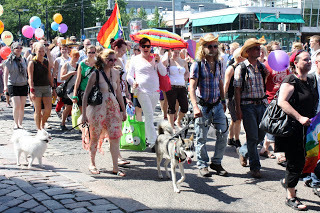
On the first Saturday of July the Helsinki Pride events culminated in a massive parade in support of the gay and lesbian communities. The parade passing through the centre of the city demonstrated great solidarity amongst the population, gay and straight alike. A year ago, there had been an attack on the parade by a gang of young right-wingers who used pepper spray and some other gas on the marchers. The perpetrators, all dressed in black, were soon arrested and dealt with. The huge participation in the parade this year must have been partly due to the actions of these nitwits. One of the key demands associated with Helsinki Pride this year was the call for a gender neutral marriage law. Most Finns would either support such legislation or pay little attention to the matter. However, due to the inclusion of the tiny Christian Democratic Party in the new coalition government, the proposal was dropped from the government's program.
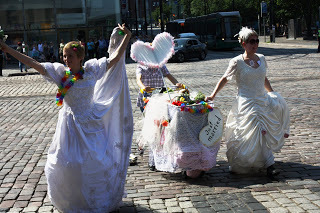
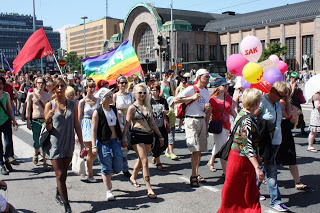
Another distinction of Helsinki is that it has more live music performances per capita than any other European city. Finland is quite well known internationally for its classical musicians and opera singers, like Karita Mattila whose performances at the New York Metropolitan have delighted opera fans (as well as those who found her nude dance as Salome titillating), as well as orchestra conductors, starting with our most famous composer Jean Sibelius. (My friend Vesa, who maintains the Sibelius website linked herewith, has recently published a massive 1,000-page volume about Finnish conductors for which he received the prestigious Finlandia prize for non-fiction.) But most of the live music takes place in clubs (and during the summer in the parks) where varieties of rock, blues and pop are performed.
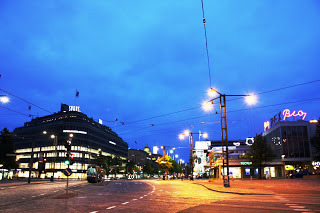
Unfortunately, the jazz scene these days leaves much to be desired (a glance at the programs of the summer's 'jazz festivals' in Finland reveals that some of the key performers include stars like Tom Jones, Elton John and Jethro Tull, who hardly are at the forefront of contemporary jazz). The most popular joint is Storyville, which I visited one evening with my friend Erkki. On most evenings, the music on offer in the pleasant basement club can barely be called jazz. At best, it tends to fall into the 'happy jazz' category or, if you're lucky, the blues. Storyville's attraction seems to be more as a venue where middle-aged women and men on the prowl can find each other and dance until it's time to go home around 3 am (but then the question is, whose home?). Somehow, more 'serious' jazz has had a hard time finding a permanent home in Helsinki in the past few years. Even the local franchise of the legendary New York club, Birdland, went bust and closed its doors after just a year of operation. There is a new club, Koko, which I heard about—that it is good and fills a niche for contemporary jazz—but didn't have the chance to visit.
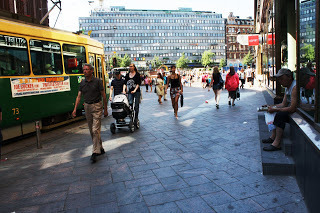
On my last morning before returning to New York the following day, I walked to the nearby Töölöntori market place for a cup of coffee. Then I continued on a lengthy walk around the shoreline. Helsinki is built on a peninsula and a large number of islands in the Gulf of Finland, so the sea is never far. The Hietaniemi beach was getting crowded already in the morning. People had spread their towels on the sand or on the rocks and grass a bit further from the sea. Pretty girls in bikinis mixed with families and older folks taking in the sun and frolicking in the waves. Had I had one more day I would have risked sunburn and skin cancer and joined them. But alas, time flies and holidays are never long enough.
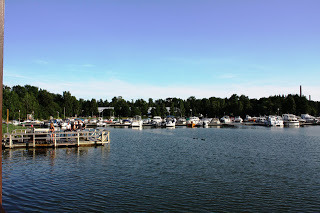
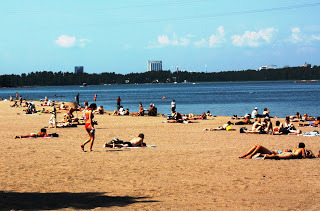
The rest of the day was spent with my friend Kari. We met early in the afternoon in the city centre. The day was already hot and the previous night had been quite late, so we decided to sit down, refresh ourselves with a lonkero and plan our route. We ended up walking for kilometers in the midday sunshine, exploring shops where I would purchase things to bring back home—Finnish music, a couple of novels (it is too seldom I read in my native language anymore), food items (such as hard bread, fish preserves, mustard) that may have more childhood nostalgia than actual nutritional value—and stopping at intervals to gather strength on a shady terrace. The long day—and my vacation back in the old country—ended on Kari's balcony where we sat listening to an eclectic collection of music from our youth—ranging from old favorites (Kate Bush, Boz Scaggs and others) to 1970s Finnish progressive jazz of Eero Koivistoinen—watching the sun go down but never quite set far behind the horizon.
Published on July 20, 2011 17:06



